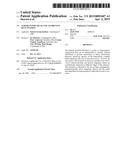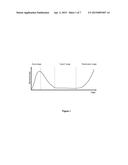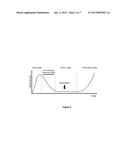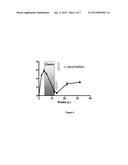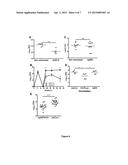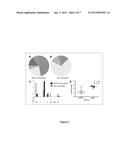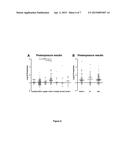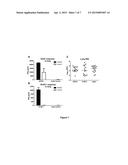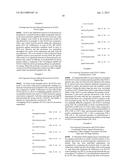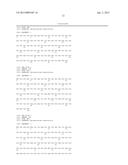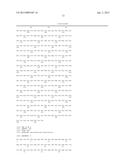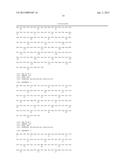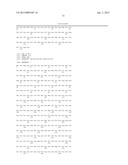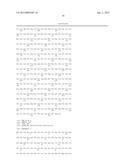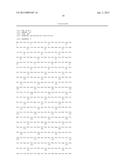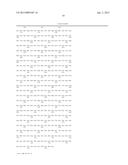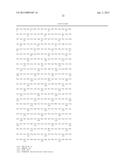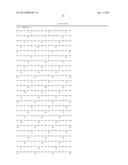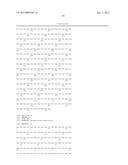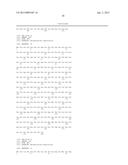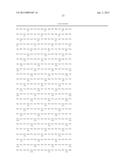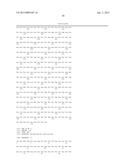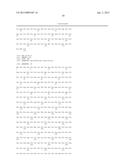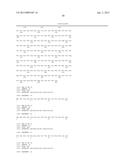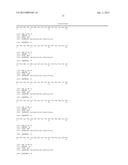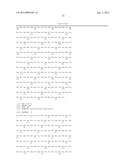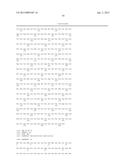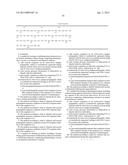Patent application title: TUBERCULOSIS TB VACCINE TO PREVENT REACTIVATION
Inventors:
Jes Dietrich (Copenhagen N, DK)
Peter Andersen (Bronshoj, DK)
Peter Andersen (Bronshoj, DK)
Carina Vingsbo-Lundberg (Hollviken, SE)
Truc Thi Kim Than Hoang (Copenhagen S, DK)
IPC8 Class: AA61K3904FI
USPC Class:
4241901
Class name: Antigen, epitope, or other immunospecific immunoeffector (e.g., immunospecific vaccine, immunospecific stimulator of cell-mediated immunity, immunospecific tolerogen, immunospecific immunosuppressor, etc.) amino acid sequence disclosed in whole or in part; or conjugate, complex, or fusion protein or fusion polypeptide including the same disclosed amino acid sequence derived from bacterium (e.g., mycoplasma, anaplasma, etc.)
Publication date: 2015-04-02
Patent application number: 20150093407
Abstract:
The present invention discloses a vaccine or immunogenic composition that
can be administered to latently infected individuals to prevent
reactivation of latent tuberculosis infection caused by species of the
tuberculosis complex microorganisms (Mycobacterium tuberculosis., M.
bovis, M. africanum), The invention is based on a number of M.
tuberculosis derived proteins and protein fragments which are
constitutively expressed in different stages of the infection. The
invention is directed to the use of these polypeptides, immunologically
active fragments thereof and the genes encoding them for immunological
compositions such as vaccines.Claims:
1. (canceled)
2. A method for treating or inhibiting latent tuberculosis in an animal, including a human being, comprising administering a vaccine to an animal in need thereof, wherein: a) said vaccine comprises an M. tuberculosis antigen polypeptide, which is constitutively expressed during infection with M. tuberculosis or a nucleic acid encoding said M. tuberculosis antigen polypeptide, b) said vaccine prevents reactivation of tuberculosis in latently infection individuals, c) said vaccine comprises an adjuvant comprising IC31 or DDA/TDB, with or without poly I:C, and d) wherein the M. tuberculosis antigen polypeptide, which is constitutively expressed, belongs to the ESX-1 secretion system and comprises: i) a first polypeptide sequence set forth in SEQ ID NO: 1, or ii) a second polypeptide sequence that comprises at least 80% sequence identity to the sequence of i), wherein said second polypeptide sequence is immunogenic.
3. The method according to claim 2, wherein the M. tuberculosis antigen polypeptide is lipidated.
4. The method according to claim 2, wherein said second polypeptide sequence comprises at least 85% sequence identity to the sequence in i).
5. The method according to claim 2, wherein said second polypeptide sequence comprises at least 90% sequence identity to the sequence in i).
6. The method according to claim 2, wherein said second polypeptide sequence comprises at least 93% sequence identity to the sequence in i).
7. The method according to claim 2, wherein said second polypeptide sequence comprises at least 95% sequence identity to the sequence in i).
8. The method according to claim 2, wherein said second polypeptide sequence comprises at least 97% sequence identity to the sequence in i).
9. A method for treating an animal, including a human being, against reactivation of tuberculosis infection caused by a virulent mycobacteria, comprising administering a vaccine to an animal in need thereof, wherein: a) said vaccine comprises an M. tuberculosis antigen polypeptide, which is constitutively expressed during infection with M. tuberculosis or a nucleic acid encoding said M. tuberculosis antigen polypeptide, b) said vaccine prevents reactivation of tuberculosis in latently infection individuals, c) said vaccine comprises an adjuvant comprising IC31 or DDA/TDB, with or without poly I:C, and d) wherein the M. tuberculosis antigen polypeptide, which is constitutively expressed, belongs to the ESX-1 secretion system and comprises: i) a first polypeptide sequence set forth in SEQ ID NO: 1, or ii) a second polypeptide sequence that comprises at least 80% sequence identity to the sequence of i), wherein said second polypeptide sequence is immunogenic.
10. The method according to claim 9, wherein said vaccine is administered during late stage infection.
11. A method for treating or inhibiting an animal, including a human being, against reactivation of latent infection caused by a species of Mycobacterium tuberculosis, M. bovis or M. africanum comprising, administering a vaccine to an animal in need thereof, wherein: a) said vaccine comprises an M. tuberculosis antigen polypeptide, which is constitutively expressed during infection with M. tuberculosis or a nucleic acid encoding said M. tuberculosis antigen polypeptide, b) said vaccine prevents reactivation of tuberculosis in latently infection individuals, c) said vaccine comprises an adjuvant comprising IC31 or DDA/TDB, with or without poly I:C, and d) wherein the M. tuberculosis antigen polypeptide, which is constitutively expressed, belongs to the ESX-1 secretion system and comprises: i) a first polypeptide sequence set forth in SEQ ID NO: 1, or ii) a second polypeptide sequence that comprises at least 80% sequence identity to the sequence of i), wherein said second polypeptide sequence is immunogenic.
12. The method according to claim 11, wherein said vaccine is administered during late stage infection.
Description:
CROSS-REFERENCE TO RELATED APPLICATIONS
[0001] This application is a divisional of and claims the benefit and priority to U.S. patent application Ser. No. 13/262,914, filed on Oct. 4, 2011, which is a U.S. National Phase application of PCT International Application Number PCT/DK2010/000054, filed on Apr. 23, 2010, designating the United States of America and published in the English language, which is an International Application of and claims the benefit of priority to Danish Patent Application No. PA 2009 00539, filed on Apr. 24, 2009. The disclosures of the above-referenced applications are hereby expressly incorporated by reference in their entireties.
REFERENCE TO SEQUENCE LISTING
[0002] The present application is being filed along with a sequence listing in electronic format. The sequence listing is provided as a file entitled SeqList_PLOUG8--005D1.txt, created Dec. 10, 2014 which is 69 KB in size. The information in the electronic format of the sequence listing is incorporated herein by reference in its entirety.
FIELD OF INVENTION
[0003] The present invention discloses a vaccine that can be administered to latently infected individuals to prevent reactivation of latent tuberculosis infection caused by species of the tuberculosis complex microorganisms (Mycobacterium tuberculosis, M. bovis, M. africanum), by targetting constitutively expressed antigens such as ESAT6, CFP10 and other antigens from the ESX-1 secretion system.
GENERAL BACKGROUND
[0004] Human tuberculosis caused by Mycobacterium tuberculosis (M. tuberculosis) is a severe global health problem, responsible for approx. 3 million deaths annually, according to the WHO. The worldwide incidence of new tuberculosis (TB) cases had been falling during the 1960s and 1970s but during recent decades this trend has markedly changed in part due to the advent of AIDS and the appearance of multidrug resistant strains of M. tuberculosis.
[0005] Organisms of the tuberculosis complex can cause a variety of diseases, but the commonest route of invasion is by inhalation of bacteria. This initiates an infection in the lung, which can ultimately spread to other parts of the body. Normally, this infection is restricted in growth by the immune system, so that the majority of infected individuals show few signs apart from cough and fever, which eventually abates. Approximately 30% of individuals are unable to contain the infection and they will develop primary disease, which in many cases will eventually prove fatal. However, it is believed that even those individuals who apparently control the infection remain infected, probably for the rest of their life. Certainly, individuals who have been healthy for years or even decades can suddenly develop tuberculosis, which has proven to be caused by the same organism they were infected with many years previously. M. tuberculosis and other organisms of the TB complex are unique in that the mycobacteria can evade the immune response and survive for long periods in a refractory non-replicating or slowly-replicating stage. This is referred to as latent TB and is at present a very significant global health problem which is estimated to affect approximately 1/3 of the world's population (Anon., 2001).
[0006] The only vaccine presently available for clinical use is BCG, a vaccine whose efficacy remains a matter of controversy. Although BCG consistently performs well in animal models of primary infection, it has clearly failed to control the TB epidemic. Consistent with that, BCG vaccination appears to provide protection against pediatric TB (which is due to primary infection), while offering little or no protection against adult disease (which is often reactivation of latent infection acquired in childhood). It has also been shown that vaccination of individuals who are currently sensitized to mycobacteria or latently infected is ineffective.
[0007] The course of a M. tuberculosis infection runs essentially through 3 phases, as illustrated in FIG. 1. During the acute phase, the bacteria proliferate in the organs, until the immune response increases to the point at which it can control the infection whereupon the bacterial load peaks and starts declining. After this, a latent phase is established where the bacterial load is kept stable at a low level. In this phase it has been the current thinking that M. tuberculosis goes from active multiplication to a state of dormancy, essentially becoming non-replicating and remaining inside the granuloma.
[0008] However, recently it has become clear that even in the stage of infection characterized by constant low bacterial numbers at least part of the bacterial population remain in a state of active metabolism (Talaat A M et al. 2007). These bacteria therefore survive, maintain an active metabolism and replicate in the face of a strong immune response. In the infected individual there is therefore a balance between non-replicating bacteria (that may be very difficult for the immune system to detect as they are located intracellularly) and slowly replicating bacteria that has an active but changed expression profile in an attempt to adapt to the hostile environment encountered in the immune host. Bacteria in this stage are typically not targeted by most of the preventive vaccines that are currently under development in the TB field as exemplified by the lack of activity when classical preventive vaccines are given to latently infected experimental animals (Turner 2000).
[0009] In some cases, the balance is tilted in favor of the pathogen and the infection goes into the reactivation phase, where the bacteria start replicating rapidly and bacterial numbers in the infected individual increases. Bacteria that replicates in latently infected individuals under very strong immune pressure is the target for the vaccination strategy in the present invention. Bacteria in this latent infective stage are typically not targeted by most of the preventive vaccines that are currently under development in the TB field as exemplified by the lack of activity when preventive vaccines are given to latently infected experimental animals (Turner et al 2000). This is not surprising as it is now known that a strong host immune response results in the down regulation of many antigens such as the major preventive vaccine antigen Ag85 and PstS (Rogerson, B J et al 2006). For Ag85B it has been shown that after infection there is an initial transient increase in Ag85B expression but already after two weeks infection the level of bacterial Ag85B expression had dropped from 0.3 transcripts per CFU of M.t.b. during the peak period to 0.02 transcripts per CFU and this low level is maintained at least up to 100 days post infection. Thus at any time point after week 2 of infection less than 2% of the bacteria actively express Ag85B (ibid.). The low expression of Ag85B is supported by a rapid drop in the number of T cells capable of making IFN-γ in response to Ag85B in the lung 3 weeks post infection or later.
[0010] In contrast some antigens are more stably (constitutively) expressed throughout the different stages of infection and one example of this is ESAT6. After the initial infection phase the ESAT-6 expression level stabilizes at 0.8 transcripts per CFU M. tuberculosis. This is a transcription level much higher than for Ag85B and this level is maintained stably up to at least 100 days post infection (Rogerson, B J et al 2006). Again transcription data is supported by immune data that shows strong T cell recognition of ESAT-6 at the later stages of infection at the site of infection (ibid.). This constitutive expression pattern is an important feature that illustrates that these molecules fulfills essential functions of crucial importance for the pathogen, functions that depends upon genes that needs to be constitutively expressed for the pathogen to survive in the immune host. These molecules are the basis for the current invention and are particularly important antigens for vaccines administered to latently infected individuals as they targets all stages of the bacterial lifestyle and therefore has the broadest possible basis for activity. This is different from current thinking that has been focused on identifying the antigens upregulated by mycobacteria during non-replicating persistence (Andersen, P. 2007, WO02048391, WO04006952, Lin M Y and Ottenhoff T H 2008; Leyten E M. et al. 2006). Although such antigens are upregulated during non-replicating persistence they may not always be available for immune recognition as the amounts available from non-replicating bacteria are below a reasonable threshold for detection or for the triggering of protective immune effector functions.
[0011] In contrast, several of the proteins from the ESX-1 secretion system have been shown to be highly immunogenic and expressed at high levels. ESX-1 is conserved in several pathogenic mycobacteria and involved in virulence of tubercle bacilli. The contribution of the individual ESX-1 proteins in secretion of ESAT-6, CFP10 and EspA has been well documented (Pym A S et al 2003; Guinn K I et al, 2004; Stanley, S A et al. 2003; Brodin, P. et al. 2006; MacGurn J A et al. 2005; Raghavan, S. et al. 2008) and the function of the effector molecules has been shown to be membrane lysis, escape from the phagosome and bacterial spreading (Gao L Y et al 2004; Smith J. et al. 2008).
[0012] The full nature of the immune response that controls latent infection and the factors that lead to reactivation are largely unknown. However, there is some evidence for a shift in the dominant cell types responsible. While CD4 T cells are essential and sufficient for control of infection during the acute phase, studies suggest that CD8 T cell responses are more important in the latent phase (van Pinxteren L A et al. 2000).
[0013] As one skilled in the art will readily appreciate, expression of a gene is not sufficient to make it a good vaccine candidate. The only way to determine if a protein is recognized by the immune system during latent infection with M. tuberculosis is to produce the given protein and test it in an appropriate assay as described herein. In this regard, our group has demonstrated that antigens strongly expressed by mycobacteria, such as ESAT-6 (Early Secretory Antigen Target-6) are recognized in individuals in all stages of infection and in fact in particular in latently infected individuals (Ravn 1999, Doherty 2002). However the ESAT-6 specific T cells primed during the natural infection are although they may be present in large numbers, almost exclusively of the so-called effector phenotype that are terminally differentiated T cells with a very limited lifespan and of low activity as protective T cells against infectious diseases (Seder R, et al. 2008). This is markedly different from the high quality, so-called polyfunctional T cells that are promoted by the vaccine demonstrated in the present study to protect against reactivation of TB.
[0014] It is far from all highly expressed and immunogenic proteins that are useful as post exposure vaccines because many will provoke hypersensitivity reactions and thereby worsen the situation instead. This was clearly demonstrated in the clinical trial of Koch's original tuberculin vaccine. The vaccine was given as a post exposure vaccine to patients suffering from different forms of the disease including skin and pulmonary TB. The trial was a complete failure and several of the enrolled patients died because of severe hypersensitive reactions (Guttstadt A. 1891). Of the several hundred antigens known to be expressed during primary infection, and tested as vaccines, less than a half dozen have demonstrated significant potential. So far only one antigen has been shown to have any potential as a post-exposure vaccine (Lowrie, 1999). However this vaccine only worked if given as a DNA vaccine, an experimental technique so far not approved for use in humans. Moreover, the technique has proved controversial, with other groups claiming that vaccination using this protocol induces either non-specific protection or even worsens disease (Turner, 2000).
[0015] Therefore, an effective postexposure vaccination strategy to protect infected individuals against reactivation of the disease is highly desirable.
SUMMARY OF THE INVENTION
[0016] The invention is related to treating infections caused by species of the tuberculosis complex (Mycobacterium tuberculosis, M. bovis, M. africanum) by a vaccine that can be administered to latently infected individuals to prevent reactivation of latent tuberculosis infection caused by species of the tuberculosis complex microorganisms (Mycobacterium tuberculosis., M. bovis, M. africanum), by targeting constitutively expressed antigens such as ESAT6, CFP10 and EspA. ESAT6, CFP10 and EspA are all interdependently required for secretion and all belong to the ESX-1 secretion system known to be essential for virulence. These secreted antigens are crucial for bacterial dissemination and lysis of cellular membranes. ESAT6, CFP10 and EspA are also antigens that are constitutively expressed in the different stages of disease--whereas, e.g., the expression of Ag85 is down regulated shortly after infection. Surprisingly immunogenic constitutively expressed antigens are preventing reactivation of latent tuberculosis infection when administered as a post exposure vaccine thereby keeping the infection latent.
DETAILED DISCLOSURE OF THE INVENTION
[0017] The invention discloses a vaccine or immunogenic composition that is administered post-exposure to latently infected individuals that prevents reactivation of tuberculosis comprising an antigen which is constitutively expressed during infection with M. tuberculosis or a nucleic acid encoding said antigen.
[0018] Preferably the composition comprises constitutively expressed antigens belonging to the ESX-1 secretion system, ESAT6 (SEQ ID NO. 1), CFP10 (SEQ ID NO. 2), EspA (SEQ ID NO.3), Rv3614c (SEQ ID NO. 4), Rv3615c (SEQ ID NO. 5), EspR (SEQ ID NO. 6), Rv3868 (SEQ ID NO. 7) Rv3869 (SEQ ID NO. 8), Rv3870 (SEQ ID NO. 9), Rv3871 (SEQ ID NO. 10), Rv3872 (SEQ ID NO. 11), Rv3873 (SEQ ID NO. 12), Rv3876 (SEQ ID NO. 13), Rv3877 (SEQ ID NO. 14), Rv3878 (SEQ ID NO. 15), Rv3879c (SEQ ID NO. 16), Rv3880c (SEQ ID NO. 17), Rv3881c (SEQ ID NO. 18), Rv3882c (SEQ ID NO 32), Rv3883c (SEQ ID NO 33), Rv3865c (SEQ ID NO 34) or an immunogenic portion, e.g. a T-cell epitope, of any one of these sequences or an amino acid sequence analogue having at least 70% sequence identity to any one of the sequences in and at the same time being immunogenic.
[0019] Alternatively the composition comprises a mix of immunogenic portions preferably selected from the group consisting of SEQ ID NO. 19, 20, 21, 22, 23, 24, 25, 26, 27, 28, 29, 30 and 31.
[0020] Another embodiment of the invention is a composition where said polypeptides are fused to an antigen expressed by bacteria within the mycobacteria family preferably where the fusion partner is an antigen which is constitutively expressed. A preferred fusion protein comprises ESAT6 fused to CFP10.
[0021] The composition according to the invention preferably comprises an additional delivery system selected among, live recombinant vaccines, that is gene-modified organisms such as bacteria or viruses expressing mycobacterial genes, or immunogenic delivery systems such as, DNA vaccines, that is plasmids expressing genes or gene fragments for the proteins described above, or protein vaccines, that is the proteins themselves or synthetic peptides derived from the proteins themselves delivered in a delivery system such as an adjuvant. The adjuvant is preferably selected from the group consisting of dimethyldioctadecylammonium bromide (DDA), Quil A, poly I:C, aluminium hydroxide, Freund's incomplete adjuvant, IFN-γ, IL-2, IL-12, monophosphoryl lipid A (MPL), Trehalose Dimycolate (TDM), Trehalose Dibehenate and muramyl dipeptide (MDP) most preferably an adjuvant promoting a polyfunctional T-cell response such as DDA/TDB and IC31.
[0022] The most preferred adjuvant comprises DDA/TDB and/or poly I:C. Alternatively the amino acid sequence is lipidated so as to allow a self-adjuvanting effect of the polypeptide.
[0023] The invention also discloses antigens described above for use in treatment of latent tuberculosis and preventing reactivation of the infection.
[0024] A method for treating an animal, including a human being, against reactivation of the tuberculosis infection caused by virulent mycobacteria, e.g. by Mycobacterium tuberculosis, Mycobacterium africanum or Mycobacterium bovis, comprising administering to the animal the vaccine or immunogenic composition described above, wherein said vaccine or immunogenic composition is administered post infection, such as during or after acute stage infection and/or during latent stage infection.
[0025] The method can comprise a step of identifying a subject latently infected with a virulent mycobacteria e.g. by a diagnostic procedure such as the Mantoux tuberculin skin test (TST), the Quantiferon test, in vitro detection of responses to HBHA or the detection of IP10 after stimulation with a constitutively expressed antigen.
[0026] The invention also discloses the use of an antigen described above for the manufacture of a postexposure vaccine or immunogenic composition against reactivation of latent infections caused by species of the tuberculosis complex e.g. Mycobacterium tuberculosis, M. bovis and M. africanum, wherein said vaccine or immunogenic composition is for administration post infection, such as during or after acute stage infection and/or during latent stage comprising one or more immunogenic portions described above.
[0027] Mycobacterium's success as a pathogen is due to the complex and delicate way it interacts with its host--a process controlled in part by the specialized ESX-1 bacterial protein-secretion system. The ESX-1 system delivers bacterial proteins (e.g. ESAT-6, CFP10 and EspA) into host cells and is critical for virulence. After being secreted from the bacilli the ESAT-6 proteins forms pores in the phagosomal membrane, allowing the bacilli to escape into the cytosol from its containment in the phagosome and thereby it facilitates cell-to-cell spread.
[0028] The constitutive expression pattern is an important feature that illustrates that these molecules fulfill essential functions of crucial importance for the pathogen, functions that depend upon genes that need to be constitutively expressed for the pathogen to survive in the immune host. These molecules are the basis for the current invention and are particularly important antigens for vaccines administered to latently infected individuals as they target all stages of the bacterial lifestyle and therefore has the broadest possible basis for activity.
[0029] ESAT6, CFP10 and EspA are all interdependently required for secretion and all belong to the ESX-1 secretion system known to be essential for virulence. These secreted antigens are crucial for bacterial dissemination and lysis of cellular membranes. ESAT6, CFP10 and EspA are also antigens that are constitutively expressed in the different stages of disease--whereas e.g. the expression of Ag85 is down regulated shortly after infection. Immunogenic constitutively expressed antigens prevent reactivation of latent tuberculosis infection when administered as a therapeutic vaccine thereby keeping the infection latent.
DEFINITIONS
Polyfunctional T Cells
[0030] By the term Polyfunctional T cells is understood T cells that simultaneously express all the cytokines IFN-γ, IL-2, and TNF-α, or IL-2 plus at least one of the two other cytokines IFN-γ and TNF-α.
Polypeptides
[0031] The word "polypeptide" in the present invention should have its usual meaning. That is an amino acid chain of any length, including a full-length protein, oligopeptides, short peptides and fragments thereof, wherein the amino acid residues are linked by covalent peptide bonds.
[0032] The polypeptide may be chemically modified by being glycosylated, by being lipidated (e.g. by chemical lipidation with palmitoyloxy succinimide as described by Mowat et al. 1991 or with dodecanoyl chloride as described by Lustig et al. 1976), by comprising prosthetic groups, or by containing additional amino acids such as e.g. a his-tag or a signal peptide.
[0033] Each polypeptide may thus be characterized by specific amino acids and be encoded by specific nucleic acid sequences. It will be understood that such sequences include analogues and variants produced by recombinant or synthetic methods wherein such polypeptide sequences have been modified by substitution, insertion, addition or deletion of one or more amino acid residues in the recombinant polypeptide and still be immunogenic in any of the biological assays described herein. Substitutions are preferably "conservative". These are defined according to the following table. Amino acids in the same block in the second column and preferably in the same line in the third column may be substituted for each other. The amino acids in the third column are indicated in one-letter code.
TABLE-US-00001 ALIPHATIC Non-polar GAP ILV Polar-uncharged CSTM NQ Polar-charged DE KR AROMATIC HFWY
[0034] A preferred polypeptide within the present invention is an immunogenic antigen from M. tuberculosis produced when the organism is subjected to the stresses associated with latent infection. Such antigen can for example also be derived from the M. tuberculosis cell and/or M. tuberculosis culture filtrate. Thus, a polypeptide comprising an immunogenic portion of one of the above antigens may consist entirely of the immunogenic portion, or may contain additional sequences. The additional sequences may be derived from the native M. tuberculosis antigen or be heterologous and such sequences may, but need not, be immunogenic.
[0035] Each polypeptide is encoded by a specific nucleic acid sequence. It will be understood that such sequences include analogues and variants hereof wherein such nucleic acid sequences have been modified by substitution, insertion, addition or deletion of one or more nucleic acid. Substitutions are preferably silent substitutions in the codon usage which will not lead to any change in the amino acid sequence, but may be introduced to enhance the expression of the protein.
[0036] In the present context the term "substantially pure polypeptide fragment" means a polypeptide preparation which contains at most 5% by weight of other polypeptide material with which it is natively associated (lower percentages of other polypeptide material are preferred, e.g. at most 4%, at most 3%, at most 2%, at most 1%, and at most 1/2%). It is preferred that the substantially pure polypeptide is at least 96% pure, i.e. that the polypeptide constitutes at least 96% by weight of total polypeptide material present in the preparation, and higher percentages are preferred, such as at least 97%, at least 98%, at least 99%, at least 99.25%, at least 99.5%, and at least 99.75%. It is especially preferred that the polypeptide fragment is in "essentially pure form", i.e. that the polypeptide fragment is essentially free of any other antigen with which it is natively associated, i.e. free of any other antigen from bacteria belonging to the tuberculosis complex or a virulent mycobacterium. This can be accomplished by preparing the polypeptide fragment by means of recombinant methods in a non-mycobacterial host cell as will be described in detail below, or by synthesizing the polypeptide fragment by the well-known methods of solid or liquid phase peptide synthesis, e.g. by the method described by Merrifield (Merrifield 1963) or variations thereof. For the purpose of the present invention it will be understood that the above definition of "substantially pure polypeptide or polypeptide fragment" does not exclude such polypeptides or polypeptide fragments when present in combination with other purified or synthetic antigens of mycobacterial or non-mycobacterial origin.
[0037] By the term "virulent mycobacterium" is understood a bacterium capable of causing the tuberculosis disease in an animal or in a human being. Examples of virulent mycobacteria include but are not limited to M. tuberculosis, M. africanum, and M. bovis. Examples of relevant animals are cattle, possums, badgers and kangaroos.
[0038] By "an infected individual" is understood an individual with culture or microscopically proven infection with virulent mycobacteria, and/or an individual clinically diagnosed with TB and who is responsive to anti-TB chemotherapy. Culture, microscopy and clinical diagnosis of TB are well known by any person skilled in the art.
[0039] By the term "PPD-positive individual" is understood an individual with a positive Mantoux test or an individual where PPD (purified protein derivative) induces a positive in vitro recall response determined by release of IFN-γ.
[0040] By "a latently infected individual" is understood an individual, who has been infected by a virulent mycobacterium, e.g. M. tuberculosis, but shows no sign of active tuberculosis. It is likely that individuals who have been vaccinated, e.g. by BCG, or treated for TB may still retain the mycobacteria within their bodies, although this is currently impossible to prove since such individuals would be expected to be positive if tested for PPD reactivity. Nonetheless, in its most accurate sense, "latently-infected" may be used to describe any individual who has M. tuberculosis residing in their tissues but who is not clinically ill. A latently infected individual can be identified by a number of methods in clinical use today such as the Mantoux tuberculin skin test (TST), the Quantiferon test and in the future there may be even more sensitive means of diagnosing this particular stage of the infection such as the recently suggested in vitro detection of responses to HBHA (Hougardy 2007) or the detection of IP10 after stimulation in vitro with ESAT6 (Ruhwald 2008)
[0041] By the term "reactivation" is understood the situation where the balance between non-replicating bacteria (that may be very difficult for the immune system to detect as they are located intracellularly) and slowly replicating bacteria that has an active but changed expression profile in an attempt to adapt to the hostile environment encountered in the immune host is tilted in favor of the pathogen and the infection goes into the phase, where the bacteria start replicating rapidly again and bacterial numbers in the infected individual increases. These bacteria that replicate in latently infected individuals under very strong immune pressure are the target for the vaccination strategy in the present invention.
[0042] By the term "IFN-γ" is understood interferon-gamma. The measurement of IFN-γ is used as an indication of an immunological response.
[0043] By the terms "nucleic acid fragment" and "nucleic acid sequence" are understood any nucleic acid molecule including DNA, RNA, LNA (locked nucleic acids), PNA, RNA, dsRNA and RNA-DNA-hybrids. Also included are nucleic acid molecules comprising non-naturally occurring nucleosides. The term includes nucleic acid molecules of any length e.g. from 10 to 10000 nucleotides, depending on the use. When the nucleic acid molecule is for use as a pharmaceutical, e.g. in DNA therapy, or for use in a method for producing a polypeptide according to the invention, a molecule encoding at least one epitope is preferably used, having a length from about 18 to about 1000 nucleotides, the molecule being optionally inserted into a vector.
[0044] Throughout this specification, unless the context requires otherwise, the word "comprise", or variations thereof such as "comprises" or "comprising", will be understood to imply the inclusion of a stated element or integer or group of elements or integers but not the exclusion of any other element or integer or group of elements or integers.
[0045] Constitutively expressed genes are defined as genes that after a detailed analysis of mRNA at a population level are equally well expressed in vivo in the lung at time points later than three weeks post infection after being correlated for M. tb. CFU numbers in the lung. From this definition it follows that a constitutive gene may be differentially expressed at a single bacteria level. The method to quantitate gene expression is quantitative PCR. "Equally well" is defined as being within +/-5 fold the level from the previous measurement The comparison is always to the time point immediately preceding the current. Time between measurements cannot be longer than the time between infection and the previous measurement. E.g. if expression of a gene is measured the first time at week 3 post infection the second measurement can not be done later than 6 weeks post infection and the third 12 weeks post infection etc.
[0046] Constitutively expressed antigens are polypeptides or part of these polypeptides which are products of constitutively expressed genes.
Sequence Identity
[0047] The term "sequence identity" indicates a quantitative measure of the degree of homology between two amino acid sequences of equal length or between two nucleotide sequences of equal length. The two sequences to be compared must be aligned to best possible fit allowing the insertion of gaps or alternatively, truncation at the ends of the protein sequences. The sequence identity can be calculated as
( N ref - N diff ) 100 N ref , ##EQU00001##
wherein Ndif is the total number of non-identical residues in the two sequences when aligned and wherein Nref is the number of residues in one of the sequences. Hence, the DNA sequence AGTCAGTC will have a sequence identity of 75% with the sequence AATCAATC(Ndif=2 and Nref=8). A gap is counted as non-identity of the specific residue(s), i.e. the DNA sequence AGTGTC will have a sequence identity of 75% with the DNA sequence AGTCAGTC(Ndif=2 and Nref=8). Sequence identity can alternatively be calculated by the BLAST program e.g. the BLASTP program (Pearson, 1988, or www.ncbi.nlm.nih.gov/cgi-bin/BLAST). In one aspect of the invention, alignment is performed with the sequence alignment method ClustalW with default parameters as described by Thompson J., et al 1994.
[0048] A preferred minimum percentage of sequence identity is at least 80%, such as at least 85%, at least 90%, at least 91%, at least 92%, at least 93%, at least 94%, at least 95%, at least 96%, at least 97%, at least 98%, at least 99%, and at least 99.5%.
Immunogenic Portion
[0049] In a preferred embodiment of the invention, the polypeptide comprises an immunogenic portion of the polypeptide, such as an epitope for a B-cell or T-cell.
[0050] The immunogenic portion of a polypeptide is a part of the polypeptide, which elicits an immune response in an animal or a human being, and/or in a biological sample determined by any of the biological assays described herein. The immunogenic portion of a polypeptide may be a T-cell epitope or a B-cell epitope. Immunogenic portions can be related to one or a few relatively small parts of the polypeptide, they can be scattered throughout the polypeptide sequence or be situated in specific parts of the polypeptide. For a few polypeptides epitopes have even been demonstrated to be scattered throughout the polypeptide covering the full sequence (Ravn et al 1999). In order to identify relevant T-cell epitopes which are recognized during an immune response, it is possible to use overlapping oligopeptides for the detection of MHC class II epitopes, preferably synthetic, having a length of e.g. 20 amino acid residues derived from the polypeptide. These peptides can be tested in biological assays (e.g. the IFN-γ assay as described herein) and some of these will give a positive response (and thereby be immunogenic) as evidence for the presence of a T cell epitope in the peptide. For ESAT-6 and CFP10 such studies have shown that every part of the antigen contains T-cell epitopes (Mustafa et al. 2000, Arend S M et al. 2000). For the detection of MHC class I epitopes it is possible to predict peptides that will bind (Stryhn et al. 1996) and hereafter produce these peptides synthetic and test them in relevant biological assays e.g. the IFN-γ assay as described herein. The peptides preferably having a length of e.g. 8 to 11 amino acid residues derived from the polypeptide. B-cell epitopes can be determined by analyzing the B cell recognition to overlapping peptides covering the polypeptide of interest as e.g. described in Harboe et al 1998. Consistent with this definition, an immunogenic portion of a polypeptide as described herein can be identified as a portion which elicits an immune response, c.f. the definition of "immune response" herein below.
[0051] Although the minimum length of a T-cell epitope has been shown to be at least 6 amino acids, it is normal that such epitopes are constituted of longer stretches of amino acids. Hence, it is preferred that the polypeptide fragment of the invention has a length of at least 7 amino acid residues, such as at least 8, at least 9, at least 10, at least 12, at least 14, at least 16, at least 18, at least 20, at least 22, at least 24, and at least 30 amino acid residues. Hence, in important embodiments of the inventive method, it is preferred that the polypeptide fragment has a length of at most 50 amino acid residues, such as at most 40, 35, 30, 25, and 20 amino acid residues. It is expected that the peptides having a length of between 10 and 20 amino acid residues will prove to be most efficient as MHC class II epitopes and therefore especially preferred lengths of the polypeptide fragment used in the inventive method are 18, such as 15, 14, 13, 12 and even 11 amino acid residues. It is expected that the peptides having a length of between 7 and 12 amino acid residues will prove to be most efficient as MHC class I epitopes and therefore especially preferred lengths of the polypeptide fragment used in the inventive method are 11, such as 10, 9, 8 and even 7 amino acid residues.
[0052] Immunogenic portions of polypeptides may be recognized by a broad part (high frequency) or by a minor part (low frequency) of the genetically heterogeneous human population. In addition some immunogenic portions induce high immunological responses (dominant), whereas others induce lower, but still significant, responses (subdominant). High frequency><low frequency can be related to the immunogenic portion binding to widely distributed MHC molecules (HLA type) or even by multiple MHC molecules (Sinigaglia, 1988, Kilgus, 1991).
[0053] In the context of providing candidate molecules for a new vaccine against tuberculosis, the subdominant epitopes are however as relevant as are the dominant epitopes since it has been shown (Olsen, 2000) that such epitopes can induce protection regardless of the fact that they are not as strongly or broadly recognized.
Variants
[0054] A common feature of the polypeptides of the invention is their capability to induce an immunological response as illustrated in the examples. It is understood that a variant of a polypeptide of the invention produced by substitution, insertion, addition or deletion may also be immunogenic as determined by any of the assays described herein.
Immune Individual
[0055] An immune individual is defined as a person or an animal, which has cleared or controlled an infection with virulent mycobacteria or has received a prophylactic vaccination, such as vaccination with M. bovis BCG.
Immune Response
[0056] The immune response may be monitored by one of the following methods:
[0057] An in vitro cellular response is determined by induction of the release of a relevant cytokine such as IFN-γ from, or the induction of proliferation in lymphocytes withdrawn from an animal or human being currently or previously infected with virulent mycobacteria or immunized with the relevant polypeptide. The induction being performed by the addition of the polypeptide or the immunogenic portion of the polypeptide to a suspension comprising from 2×105 cells to 4×105 cells per well. The cells being isolated from either the blood, the spleen, the liver or the lung and the addition of the polypeptide or the immunogenic portion resulting in a concentration of not more than 20 μg per ml suspension and the stimulation being performed from two to five days. For monitoring cell proliferation the cells are pulsed with radioactive labeled Thymidine and after 16-22 hours of incubation detecting the proliferation by liquid scintillation counting. A positive response is defined as being a response more than background plus two standard deviations. The release of IFN-γ can be determined by the ELISA method, which is well known to a person skilled in the art. A positive response being a response more than background plus two standard deviations. Other cytokines than IFN-γ could be relevant when monitoring the immunological response to the polypeptide, such as IL-12, TNF-α, IL-4, IL-5, IL-10, IL-6, TGF-β. Another and more sensitive method for detecting the immune response is the ELISpot method, in which the frequency of IFN-γ producing cells is determined. In an ELlspot plate (MAHA, Millipore) precoated with anti-murine IFN-γ antibodies (PharMingen) graded numbers of cells isolated from either blood, spleen, or lung (typically between 1 to 4×105 cells/well) are incubated for 24-32 hrs in the presence of the polypeptide or the immunogenic portion resulting in a concentration of not more than 20 μg per ml. The plates are subsequently incubated with biotinylated anti-IFN-γ antibodies followed by a streptavidin-alkaline phosphatase incubation. The IFN-γ producing cells are identified by adding BCIP/NBT (Sigma), the relevant substrate giving rise to spots. These spots can be enumerated using a dissection microscope. It is also a possibility to determine the presence of mRNA coding for the relevant cytokine by the use of the PCR technique. Usually one or more cytokines will be measured utilizing for example PCR, ELISPOT or ELISA. It will be appreciated by a person skilled in the art that a significant increase or decrease in the amount of any of these cytokines induced by a specific polypeptide can be used in evaluation of the immunological activity of the polypeptide.
[0058] An in vitro cellular response may also be determined by the use of T cell lines derived from an immune individual or an M. tuberculosis-infected person where the T cell lines have been driven with either live mycobacteria, extracts from the bacterial cell or culture filtrate for 10 to 20 days with the addition of IL-2. The induction being performed by addition of not more than 20 μg polypeptide per ml suspension to the T cell lines containing from 1×105 cells to 3×105 cells per well and incubation being performed from two to six days. The induction of IFN-γ or release of another relevant cytokine is detected by ELISA. The stimulation of T cells can also be monitored by detecting cell proliferation using radioactively labeled Thymidine as described above. For both assays a positive response being a response more than background plus two standard deviations.
[0059] An in vivo cellular response may be determined as a positive DTH response after intradermal injection or local application patch of at most 100 μg of the polypeptide or the immunogenic portion to an individual who is clinically or subclinically infected with a virulent mycobacterium, a positive response having a diameter of at least 5 mm 72-96 hours after the injection or application.
[0060] An in vitro humoral response is determined by a specific antibody response in an immune or infected individual. The presence of antibodies may be determined by an ELISA technique or a Western blot where the polypeptide or the immunogenic portion is absorbed to either a nitrocellulose membrane or a polystyrene surface. The serum is preferably diluted in PBS from 1:10 to 1:100 and added to the absorbed polypeptide and the incubation being performed from 1 to 12 hours. By the use of labeled secondary antibodies the presence of specific antibodies can be determined by measuring the OD e.g. by ELISA where a positive response is a response of more than background plus two standard deviations or alternatively a visual response in a Western blot.
[0061] Another relevant parameter is measurement of the protection in animal models induced after vaccination with the polypeptide in an adjuvant or after DNA vaccination. Suitable animal models include primates, guinea pigs or mice, which are challenged with an infection of a virulent Mycobacterium. Readout for induced protection could be decrease of the bacterial load in target organs compared to non-vaccinated animals, prolonged survival times compared to non-vaccinated animals and diminished weight loss compared to non-vaccinated animals.
Preparation Methods
[0062] In general, M. tuberculosis antigens, and DNA sequences encoding such antigens, may be prepared using any one of a variety of procedures.
[0063] They may be purified as native proteins from the M. tuberculosis cell or culture filtrate by procedures such as those described above. Immunogenic antigens may also be produced recombinantly using a DNA sequence encoding the antigen, which has been inserted into an expression vector and expressed in an appropriate host. Examples of host cells are E. coli. The polypeptides or immunogenic portion hereof can also be produced synthetically having fewer than about 100 amino acids, and generally fewer than 50 amino acids and may be generated using techniques well known to those ordinarily skilled in the art, such as commercially available solid-phase techniques where amino acids are sequentially added to a growing amino acid chain.
[0064] In the construction and preparation of plasmid DNA encoding the polypeptide as defined for DNA vaccination a host strain such as E. coli can be used. Plasmid DNA can then be prepared from cultures of the host strain carrying the plasmid of interest, and purified using e.g. the Qiagen Giga--Plasmid column kit (Qiagen, Santa Clarita, Calif., USA) including an endotoxin removal step. It is preferred that plasmid DNA used for DNA vaccination is endotoxin free.
Fusion Proteins
[0065] The immunogenic polypeptides may also be produced as fusion proteins, by which methods superior characteristics of the polypeptide of the invention can be achieved. For instance, fusion partners that facilitate export of the polypeptide when produced recombinantly, fusion partners that facilitate purification of the polypeptide, and fusion partners which enhance the immunogenicity of the polypeptide fragment of the invention are all interesting possibilities. Therefore, the invention also pertains to a fusion polypeptide comprising at least one polypeptide or immunogenic portion defined above and at least one fusion partner. The fusion partner can, in order to enhance immunogenicity, be another polypeptide derived from M. tuberculosis, such as of a polypeptide fragment derived from a bacterium belonging to the tuberculosis complex, such as ESAT-6, CFP10, EspA, TB10.4, RD1-ORF5, RD1-ORF2, Rv1036, MPB64, MPT64, Ag85A, Ag85B (MPT59), MPB59, Ag85C, 19 kDa lipoprotein, MPT32 and alpha-crystallin, or at least one T-cell epitope of any of the above mentioned antigens (Skjot et al 2000; WO0179274; WO0104151; U.S. patent application Ser. No. 09/505,739; Rosenkrands et al 1998; Nagai et al 1991). The invention also pertains to a fusion polypeptide comprising mutual fusions of two or more of the polypeptides (or immunogenic portions thereof) of the invention.
[0066] Other fusion partners, which could enhance the immunogenicity of the product, are lymphokines such as IFN-γ, IL-2 and IL-12. In order to facilitate expression and/or purification, the fusion partner can e.g. be a bacterial fimbrial protein, e.g. the pilus components pilin and papA; protein A; the ZZ-peptide (ZZ-fusions are marketed by Pharmacia in Sweden); the maltose binding protein; glutathione S-transferase; β-galactosidase; or poly-histidine. Fusion proteins can be produced recombinantly in a host cell, which could be E. coli, and it is a possibility to induce a linker region between the different fusion partners.
[0067] Other interesting fusion partners are polypeptides, which are lipidated so that the immunogenic polypeptide is presented in a suitable manner to the immune system. This effect is e.g. known from vaccines based on the Borrelia burgdorferi OspA polypeptide as described in e.g. WO 96/40718 A or vaccines based on the Pseudomonas aeruginosa OprI lipoprotein (Cote-Sierra J 1998). Another possibility is N-terminal fusion of a known signal sequence and an N-terminal cystein to the immunogenic polypeptide. Such a fusion results in lipidation of the immunogenic polypeptide at the N-terminal cystein, when produced in a suitable production host.
Uses
Vaccine
[0068] A vaccine is a biological preparation that establishes or improves immunity to a particular disease. Vaccines can be prophylactic (e.g. to prevent or ameliorate the effects of a future infection by any natural or "wild" pathogen), postexposure (e.g. to prevent reactivation in latently infected individuals without clinical symptoms) or therapeutic (e.g. vaccines used to treat active disease either alone or combined with antibiotic treatment to shorten treatment)
An Animal Model for Latent TB
[0069] To induce a low grade latent infection with M. tb., animals are first given an aerosol infection using a normal dose of M. tb (approximately 150 bacteria in the lungs). After 6 weeks of infection, the animals are then given a suboptimal chemotherapy treatment of 6 weeks during which most--but not all--of the bacteria are eradicated. The remaining bacteria will establish a latent infection. Following the chemotherapy treatment some animals will be vaccinated to examine the ability of the vaccine to prevent re-activation of the latent infection, which will occur spontaneously 5-15 weeks after the chemotherapy treatment. See FIG. 2.
Protein Vaccine
[0070] Another part of the invention pertains to a vaccine composition comprising a polypeptide (or at least one immunogenic portion thereof) or fusion polypeptide according to the invention. In order to ensure optimum performance of such a vaccine composition it is preferred that it comprises an immunologically and pharmaceutically acceptable carrier, vehicle or adjuvant.
[0071] An effective vaccine, wherein a polypeptide of the invention is recognized by the animal, will in an animal model be able to decrease bacterial load in target organs, prolong survival times and/or diminish weight loss after challenge with a virulent Mycobacterium, compared to non-vaccinated animals
[0072] Suitable carriers are selected from the group consisting of a polymer to which the polypeptide(s) is/are bound by hydrophobic non-covalent interaction, such as a plastic, e.g. polystyrene, or a polymer to which the polypeptide(s) is/are covalently bound, such as a polysaccharide, or a polypeptide, e.g. bovine serum albumin, ovalbumin or keyhole limpet haemocyanin. Suitable vehicles are selected from the group consisting of a diluent and a suspending agent. The adjuvant is preferably selected from the group consisting of dimethyldioctadecylammonium bromide (DDA), Quil A, poly I:C, aluminium hydroxide, Freund's incomplete adjuvant, IFN-γ, IL-2, IL-12, monophosphoryl lipid A (MPL), Trehalose Dimycolate (TDM), Trehalose Dibehenate and muramyl dipeptide (MDP).
[0073] Preparation of vaccines which contain peptide sequences as active ingredients is generally well understood in the art, as exemplified by U.S. Pat. Nos. 4,608,251; 4,601,903; 4,599,231 and 4,599,230, all incorporated herein by reference.
[0074] Other methods of achieving adjuvant effect for the vaccine include use of agents such as aluminum hydroxide or phosphate (alum), synthetic polymers of sugars (Carbopol), aggregation of the protein in the vaccine by heat treatment, aggregation by reactivating with pepsin treated (Fab) antibodies to albumin, mixture with bacterial cells such as C. parvum or endotoxins or lipopolysaccharide components of gram-negative bacteria, emulsion in physiologically acceptable oil vehicles such as mannide mono-oleate (Aracel A) or emulsion with 20 percent solution of a perfluorocarbon (Fluosol-DA) used as a block substitute may also be employed. Other possibilities involve the use of immune modulating substances such as cytokines or synthetic IFN-γ inducers such as poly I:C in combination with the above-mentioned adjuvants.
[0075] Another interesting possibility for achieving adjuvant effect is to employ the technique described in Gosselin et al., 1992 (which is hereby incorporated by reference herein). In brief, a relevant antigen such as an antigen of the present invention can be conjugated to an antibody (or antigen binding antibody fragment) against the Fcγ receptors on monocytes/macrophages.
[0076] The vaccines are administered in a manner compatible with the dosage formulation, and in such amount as will be immunogenic and effective in preventing re-activation. The quantity to be administered depends on the subject to be treated, including, e.g., the capacity of the individual's immune system to mount an immune response, and the degree of protection desired. Suitable dosage ranges are of the order of several hundred micrograms active ingredient per vaccination with a preferred range from about 0.1 μg to 1000 μg, such as in the range from about 1 μg to 300 μg, and especially in the range from about 10 μg to 50 μg. Suitable regimens for initial administration and booster shots are also variable but are typified by an initial administration followed by subsequent inoculations or other administrations.
[0077] The manner of application may be varied widely. Any of the conventional methods for administration of a vaccine are applicable. These are believed to include oral application on a solid physiologically acceptable base or in a physiologically acceptable dispersion, parenterally, by injection or the like. The dosage of the vaccine will depend on the route of administration and will vary according to the age of the person to be vaccinated and, to a lesser degree, the size of the person to be vaccinated.
[0078] The vaccines are conventionally administered intra pulmonary, e.g. by aerosol or inhalation, parenterally, by injection, for example, either subcutaneously or intramuscularly. Additional formulations which are suitable for other modes of administration include suppositories and, in some cases, oral formulations. For suppositories, traditional binders and carriers may include, for example, polyalkalene glycols or triglycerides; such suppositories may be formed from mixtures containing the active ingredient in the range of 0.5% to 10%, preferably 1-2%. Oral formulations include such normally employed excipients as, for example, pharmaceutical grades of mannitol, lactose, starch, magnesium stearate, sodium saccharine, cellulose, magnesium carbonate, and the like. These compositions take the form of solutions, suspensions, tablets, pills, capsules, sustained release formulations or powders and advantageously contain 10-95% of active ingredient, preferably 25-70%.
[0079] In many instances, it will be necessary to have multiple administrations of the vaccine. In instances where the individual has already become infected or is suspected to have become infected, the previous vaccination may have provided sufficient immunity to prevent primary disease, but as discussed previously, boosting this immune response will not help against the latent infection. In such a situation, the vaccine will necessarily have to be a post exposure vaccine designed for efficacy against the latent stage of infection or reemerging active tuberculosis infection.
[0080] Due to genetic variation, different individuals may react with immune responses of varying strength to the same polypeptide. Therefore, the vaccine according to the invention may comprise several different polypeptides in order to increase the immune response. The vaccine may comprise two or more polypeptides or immunogenic portions, where all of the polypeptides are as defined above, or some but not all of the peptides may be derived from virulent mycobacteria. In the latter example, the polypeptides not necessarily fulfilling the criteria set forth above for polypeptides may either act due to their own immunogenicity or merely act as adjuvants.
[0081] The vaccine may comprise 1-20, such as 2-20 or even 3-20 different polypeptides or fusion polypeptides, such as 3-10 different polypeptides or fusion polypeptides.
DNA Vaccine.
[0082] The nucleic acid fragments of the invention may be used for effecting in vivo expression of antigens, i.e. the nucleic acid fragments may be used in so-called DNA vaccines as reviewed in Ulmer et al 1993, which is included by reference.
[0083] Hence, the invention also relates to a post exposure vaccine comprising a nucleic acid fragment according to the invention, the vaccine effecting in vivo expression of antigen by an animal, including a human being, to whom the vaccine has been administered, the amount of expressed antigen being effective to confer treatment of the infections caused by virulent mycobacteria in an animal, including a human being.
[0084] The efficacy of such a DNA vaccine can possibly be enhanced by administering the gene encoding the expression product together with a DNA fragment encoding a polypeptide which has the capability of modulating an immune response.
Live Recombinant Vaccines
[0085] One possibility for effectively activating a cellular immune response for a post exposure vaccine can be achieved by expressing the relevant antigen in a vaccine in a non-pathogenic microorganism or virus. Well-known examples of such microorganisms are Mycobacterium bovis BCG, Salmonella and Pseudomona and examples of viruses are Vaccinia Virus and Adenovirus.
[0086] Therefore, another important aspect of the present invention is an improvement of the living BCG vaccine presently available, wherein one or more copies of a DNA sequence encoding one or more polypeptide as defined above has been incorporated into the genome of the micro-organism in a manner allowing the micro-organism to express and secrete the polypeptide. The incorporation of more than one copy of a nucleotide sequence of the invention is contemplated to enhance the immune response.
[0087] Another possibility is to integrate the DNA encoding the polypeptide according to the invention in an attenuated virus such as the vaccinia virus or Adenovirus (Rolph et al 1997). The recombinant vaccinia virus is able to replicate within the cytoplasma of the infected host cell and the polypeptide of interest can therefore induce an immune response, which is envisioned to induce protection against TB.
[0088] All patent and non-patent references cited in the present application, are hereby incorporated by reference in their entirety. The invention will now be described in further details in the following non-limiting examples.
FIGURE LEGENDS
[0089] FIG. 1: The course of a M. tuberculosis infection runs essentially through 3 phases
[0090] FIG. 2: Model for post-exposure vaccination to prevent reactivation
[0091] FIG. 3: TB vaccination model.
[0092] A schematic overview of the model used at the SSI for the testing of post-exposure vaccines. Mice are infected with virulent M. tb by the aerosol route. From weeks 6 to week 12 post infection mice are treated with antibiotics to establish a state of latent TB. The mice are vaccinated 2 to three times with 3 weeks interval initiated at week 10 post infection with the post-exposure vaccine candidates. The mice are allowed time to reactivate the disease and approximately 20 weeks later the lungs are assessed for bacterial numbers to assess the protective efficacy of the vaccine.
[0093] FIG. 4: Post-exposure vaccine induced protection by ESAT6 but not Ag85.
[0094] Mice were infected, treated and vaccinated according to the schematic overview in example 1. Mice were killed between week 30-40 post infection and at this time point lungs were assessed for bacterial load (Figure A, C-E) or as displayed in FIG. 4B where the bacterial load was determined at several time points throughout infection for ESAT6. (A and B) Bacterial load of ESAT6 vaccinated compared to control animals. (C) Bacterial load of Ag85B vaccinated compared to control animals. (D) Bacterial of ESAT-6 pepmix vaccinated (pool of overlapping peptides covering the entire ESAT6 sequence) compared to both Ag85B vaccinated and control animals. (E) Protection against reactivation following postexposure vaccination with Ag85B-ESAT-6 (H1) vaccinated compared to non-vaccinated control mice. All data in FIG. 4A, C-E are displayed as dot plots representing each individual animal with the mean depicted whereas each time point in FIG. 4B is representative of 6 individual animals and displayed as mean±standard error of the mean (SEM) (B). All statistical analyses were performed using either an unpaired t-test (Figure A-C and E) or Tukey's multiple comparison test (figure D) where p<0.05 was considered significant.
[0095] FIG. 5: ESAT-6 postexposure vaccination induce polyfunctional T cells.
[0096] Cells from infected lungs from non-vaccinated or ESAT-6 vaccinated animals were stimulated in vitro with ESAT-6 prior to staining with anti-CD4, -CD8, -IFN-γ, -TNF-α and -IL-2. (A and B) Cytokine profiles were determined by first dividing the CD4 T cells into IFN-γ positive (+) or IFN-γ negative (-) cells. Both the IFN-γ+ and IFN-γ- cells were analyzed with respect to the production of TNF-α and IL-2. The pie charts (A and B) are colour coded according to the cytokine production profile and summarizes the fractions of the CD4.sup.+ T cell response (out of the ESAT-6 specific CD4 T cells) that are positive for a given cytokine production profile. (C) Every possible combination of cytokines is shown on the x-axis of the bar chart and the percentage of ESAT-6 specific CD4.sup.+ T cells in non vaccinated mice (grey bars) or ESAT-6 vaccinated mice (Black bars) expressing any combination of cytokines is given for each immunization group. D. Latently infected mice were vaccinated twice with ESAT-6, and 20 weeks after the last vaccination, lungs were assessed for bacterial number to determine protective efficacy. (**p<0.01, One way ANOVA Tukey's multiple comparisons test).
[0097] FIG. 6: Pooled analysis of all post-exposure experiments
[0098] For an individual experiment where either ESAT6, Rv3871, Ag85B, Rv3905, Rv3445, Rv0569 or Rv2031c (Figure A), Ag85B-ESAT6 (H1) or Ag85B-ESAT6-Rv2660 (H56) (Figure B) was used for post-exposure vaccination the median of the bacterial load of the adjuvant control group was compared to the bacterial load of each individual mouse in a vaccinated group vaccinated with either one of the antigens mentioned above. In figure A and B each dot corresponds to the level of protection i.e. Δ Log 10 CFU conferred by the vaccination compared to the adjuvant control group and consists of several independent experiments. (A) Log 10 protection for the single antigens ESAT6, Rv3871, Ag85B, Rv3905, Rv3445, Rv0569 or Rv2031c (B) or for the hybrid antigens H1 and H56 compared to ESAT6 alone. A statistical analysis was applied for comparisons of medians between the different groups either using the Kruskall Wallis multiple comparison test. p<0.05 was considered significant.
[0099] FIG. 7: Effect of post-exposure vaccination with Rv3871 compared to ESAT6 and control animals.
[0100] Mice were infected, treated and vaccinated at week 10, 13 and 18 post infection. At week 36 post infection the mice were terminated and lung lymphocytes from both vaccinated and non-vaccinated saline control mice were restimulated in vitro with Rv3871 (FIG. 7A) or ESAT6 (FIG. 7B). IFN-γ releases assessed by ELISA and samples were performed in triplicated. Data are depicted as mean±SEM. The protective efficacy conferred by the vaccines was determined by enumeration of bacteria in the lung cultured from full lung homogenate (n=16-18). FIG. 7C shows data displayed as a dot plot where each dot represents an individual animal and depicted with the median (line).
EXAMPLES
Example 1
Murine TB Model for Vaccination
[0101] The Cornell model has widely been used as a murine model for the study of latent TB. This model has been adapted in our laboratory for the testing of the ability of vaccine candidates to prevent reactivation. Mice are initially aerosolly infected with virulent M. tb. and at week 6 post infection antibiotic treatment is initiated to reduce the bacterial load. This is to mimic the latent stage of a human infection which does not occur spontaneously in mice. During this latent stage (a stage with continuous low bacterial numbers) the mice are being immunized twice and the ability to prevent reactivation by the vaccine is determined by culturing the spleen and lungs for live M. tb. 20 weeks after the last immunization. The long timespan of the experiments is necessary to allow sufficient time for reactivation of the disease which is a prerequisite for readout of vaccine efficacy (FIG. 3).
Example 2
Postexposure Vaccine Induced Protection by ESAT6 but not Ag85
[0102] ESAT-6 and Ag85B have proven to be protective in prophylactic vaccination both as single components and also as the fusion molecule Ag85B-ESAT6 (H1). However, when these antigens were tested in the postexposure model (as described above in example 1) only ESAT6 has a protective effect and control bacteria growth during the reactivation phase (FIG. 4). Furthermore, as seen in FIG. 4B ESAT6 protection against reactivation manifests itself as early as W18 post infection and this protection was maintained throughout the course of the experiment (up until week 40 post infection). This is in contrast to what is observed when Ag85B is used as a post exposure vaccine (FIGS. 4C and D), where there is no significant decrease in bacterial load compared to the control. In addition, we evaluated the H1 fusion protein which is composed of the TB antigens Ag85B and ESAT-6 which has shown promising efficacy in a prophylactic setting. When this molecule was used as a post exposure vaccine in the SSI postexposure model it was able to significantly reduce the bacterial numbers (FIG. 4E).
Example 3
Post Exposure Vaccine Induced Protection by ESAT6 Peptide Mix
[0103] As shown in the examples above, the ESAT-6 molecule is very active when given postexposure resulting in a decrease in bacterial load compared to the control group and also compared to Ag85B. Furthermore we have shown that ESAT-6 given as a pool of overlapping peptides instead of a recombinant protein also lead to a better protection against reactivation compared to both the control group and Ag85B demonstrating the strong activity of ESAT6, and ability to function as a post exposure vaccine (FIG. 4D).
Overlapping ESAT-6 peptides (P1-P13) used for protection experiment:
TABLE-US-00002 P1 (SEQ ID NO. 19) MTEQQWNFAGIEAAA P2 (SEQ ID NO. 20) NFAGIEAAASAIQGN P3 (SEQ ID NO. 21) ASAIQGNVTSIHSLL P4 (SEQ ID NO. 22) NVTSIHSLLDEGKQS P5 (SEQ ID NO. 23) SLLDEGKQSLTKLAA P6 (SEQ ID NO. 24) KQSLTKLAAAWGGSG P7 (SEQ ID NO. 25) AAWGGSGSEAYQGVQ P8 (SEQ ID NO. 26) GSEAYQGVQQKWDAT P9 (SEQ ID NO. 27) QQKWDATATELNNAL P10 (SEQ ID NO. 28) TATELNNALQNLART P11 (SEQ ID NO. 29) ALQNLARTISEAGQA P12 (SEQ ID NO. 30) TISEAGQAMASTEGN P13 (SEQ ID NO. 31) QAMASTEGNVTGMFA
Example 5
Post Exposure Vaccination with ESAT-6 Induce Polyfunctional T Cells
[0104] To examine the effect of a post exposure vaccination with ESAT-6 on the cytokine expression profile of the ESAT-6 specific cells, mice were first aerosolly infected with virulent M. tb. and at week 6 post infection antibiotic treatment was initiated to reduce the bacterial load and establish a latent infection. During the latent stage the mice were vaccinated (as shown in FIG. 3) three times with 3 weeks interval and the ability of the ESAT-6 vaccine influence the number of polyfunctional T cells and to prevent reactivation of M. tb was determined 20 weeks after the last vaccination. The results showed that there was a substantial ESAT-6 response in the non-vaccinated group, but the cytokine expression profile was markedly different compared to the ESAT-6 vaccinated group (FIG. 5), in particularly in terms of polyfunctional T cells (IFN-γ+TNF-α+IL-2+ CD4 T cells). Thus, compared to the non vaccinated group, we observed decreased numbers of IFN-γ/TNF-α CD4 T cells, and increased numbers of triple positive polyfunctional CD4 T cells co-expressing IFN-γ/TNF-α/IL-2. The increased presence of polyfunctional T cells correlated with decreased bacterial numbers in the lungs of ESAT-6 vaccinated animals (FIG. 5 D).
Example 6
Post-Exposure Vaccination with ESAT6 More Consistently Protects Against Reactivation Compared to Other Antigens Associated with Both Early and Late Stage Infection
[0105] To determine which antigens most consistently protect against reactivation we made a pooled analysis of normalized data based on all post-exposure experiments conducted. Data sets from individual experiments was normalized by comparing the bacterial load of each individual mice within a group to the median of the control group i.e. each data point represents the difference (Log 10 CFU control median-Log 10CFU vaccine group) between the control median CFU and the CFU of each individual animal (FIG. 6). In FIG. 6A comparison of the pooled data set for protection for the antigens latency associated antigens Rv0569, Rv2031c and the early antigens Ag85B, ESAT6, Rv3871, Rv3905 and Rv3445 of which the two latter are ESAT6 family proteins show that ESAT6 vaccinated animals are significantly better protected against reactivation compared to other antigens evaluated. Furthermore, protective levels attained following post-exposure vaccination with Rv3871, an ESX-1 protein also seem to be elevated compared to the other antigens (FIG. 6A). To further demonstrate the activity of ESAT6 in particular we compared the protection conferred by ESAT6 to the two fusion constructs H1 (Ag85B-ESAT6) and H56 (Ag85B-ESAT6-Rv2660) both of which contain ESAT6 (FIG. 6B). The analysis show that ESAT6 activity still result in protection against reactivation when included in the two above mentioned fusion constructs.
Example 7
Postexposure Vaccination with Another Member of the ESX-1 Family, Rv3871 Seems to have an Inhibitory Effect on the Reactivation Process
[0106] We evaluated other members of the ESX-1 family in parallel with ESAT6 and found that Rv3871 postexposure vaccination led to an induction of Rv3871 specific immune response (FIG. 7B) although not to the extent of the ESAT6 induced immune response (FIG. 7A). Nevertheless both ESAT6 and Rv3871 induced immune response were greater compared to saline control animals. The induction of vaccine specific immune response was associated with a lowered (median) bacterial load in both vaccine groups compared to the saline group. This indicated that Rv3871 may have a similar effect in protection against reactivation compared to ESAT6 demonstrated by the similar levels of bacterial numbers in these two groups compared to the somewhat elevated level in the control group (FIG. 7C)
REFERENCES
[0107] Andersen, P. 2007 15(1), 7-13
[0108] Anon. 2001. Global Tuberculosis Control. WHO Report.
[0109] Arend, S M., Infect Immun. 2000 68(6): 3314-3321.
[0110] Brodin, P. et al. Infect Immun. 2006, 74, 88-98
[0111] Cote-Sierra J, et al 1998, Gene October 9; 221(1):25-34
[0112] Doherty T M et al., 2002, J Clin Microbiol. February; 40(2):704-6.
[0113] Gao L Y et al 2004, Molecular Microbiology 1677-93
[0114] Gosselin et al., 1992. J. Immunol. 149: 3477-3481
[0115] Guinn K I et al, 2004, Mol Microbiol. 51, 359-70
[0116] Guttstadt, A 1891. Die Wirksamkeit des Koch'schen Heilmittels gegen Tuberculosis, Polykliniken and Pathologisch/Anatomischen Institute der Preussischen Universitaten. Springer, Berlin.
[0117] Harboe, M., et al 1998 Infect. Immun. 66:2; 717-723
[0118] Hougardy et al 2007, PLoS ONE. October 3; 2(10):e926
[0119] Kilgus J et al, J Immunol. 1991 Jan. 1; 146(1):307-15
[0120] Leyten E M. Et al. Microbes Infect. 2006 8(8):2052-60.
[0121] Lin M Y and Ottenhoff T H, Biol. Chem. 2008, 389 (5):497-511
[0122] Lowrie, D. B. et al 1999, Nature 400: 269-71
[0123] Lustig et al 1976, Cell Immunol 24(1):164-7
[0124] MacGurn J A et al. Mol Microbiol. 2005, 57:1653-63
[0125] Merrifield, R. B. Fed. Proc. Am. Soc. Ex. Biol. 21: 412, 1962 and J. Am. Chem. Soc. 85: 2149, 1963
[0126] Mowat et al 1991, Immunology 72(3):317-22
[0127] Mustafa, A S et al. 2000, Clin. Infect. Dis. 30 (suppl. 3) S201-S205
[0128] Nagai et al 1991, Infect. Immun 59:1; 372-382
[0129] Olsen A W et al, Eur J Immunol. 2000 June; 30(6):1724-32
[0130] Pym A S et al Nat Med 2003, 9, 533-9;
[0131] Pearson, W R. et al. 1988. Proc Natl Acad Sci USA, 85, 2444-2448.
[0132] Raghavan, S. et al. 2008, Nature 454, 717-721
[0133] Ravn, P. et al 1999. J. Infect. Dis. 179:637-645
[0134] Rolph, M S, and I. A. Ramshaw. 1997. Curr. Opin. Immunol. 9:517-24
[0135] Rogerson, B J et al Immunology 2006, 118, 195-201
[0136] Rosenkrands, I., et al 1998, Infect. Immun 66:6; 2728-2735
[0137] Ruhwald M. et al 2008 PLoS ONE. August 6; 3(8):e2858
[0138] Sambrook et al Molecular Cloning; A laboratory manual, Cold Spring Harbor Laboratories, NY, 1989
[0139] Seder, Nat. Rew. Immunol. 2008; 8(4):247-58
[0140] Sinigaglia F et al. Nature 1988 Dec. 22-29; 336(6201):778-80
[0141] Skjot, RLV., et al 2000, Infect. Immun 68:1; 214-220
[0142] Smith J. et al. 2008, Infect Immun 76, 5478-87
[0143] Stanley, S A et al. 2003 Proc Natl Acad. Sci USA 100:12420-5
[0144] Stryhn, A., et al 1996 Eur. J. Immunol. 26:1911-1918
[0145] Turner, O C et al 2000 Infect Immun. 68:6: 3674-9.
[0146] Talaat A M et al. 2007, J of Bact 189, 4265-74
[0147] Thompson J., et al Nucleic Acids Res 1994 22:4673-4680
[0148] Ulmer J. B et al 1993, Curr. Opin. Invest. Drugs 2(9): 983-989
[0149] van Pinxteren L A et al. 2000. Eur. J. Immunol. 30: 3689-98.
Sequence CWU
1
1
34195PRTMycobacterium tuberculosis 1Met Thr Glu Gln Gln Trp Asn Phe Ala
Gly Ile Glu Ala Ala Ala Ser 1 5 10
15 Ala Ile Gln Gly Asn Val Thr Ser Ile His Ser Leu Leu Asp
Glu Gly 20 25 30
Lys Gln Ser Leu Thr Lys Leu Ala Ala Ala Trp Gly Gly Ser Gly Ser
35 40 45 Glu Ala Tyr Gln
Gly Val Gln Gln Lys Trp Asp Ala Thr Ala Thr Glu 50
55 60 Leu Asn Asn Ala Leu Gln Asn Leu
Ala Arg Thr Ile Ser Glu Ala Gly 65 70
75 80 Gln Ala Met Ala Ser Thr Glu Gly Asn Val Thr Gly
Met Phe Ala 85 90 95
2100PRTMycobacterium tuberculosis 2Met Ala Glu Met Lys Thr Asp Ala Ala
Thr Leu Ala Gln Glu Ala Gly 1 5 10
15 Asn Phe Glu Arg Ile Ser Gly Asp Leu Lys Thr Gln Ile Asp
Gln Val 20 25 30
Glu Ser Thr Ala Gly Ser Leu Gln Gly Gln Trp Arg Gly Ala Ala Gly
35 40 45 Thr Ala Ala Gln
Ala Ala Val Val Arg Phe Gln Glu Ala Ala Asn Lys 50
55 60 Gln Lys Gln Glu Leu Asp Glu Ile
Ser Thr Asn Ile Arg Gln Ala Gly 65 70
75 80 Val Gln Tyr Ser Arg Ala Asp Glu Glu Gln Gln Gln
Ala Leu Ser Ser 85 90
95 Gln Met Gly Phe 100 3392PRTMycobacterium tuberculosis
3Met Ser Arg Ala Phe Ile Ile Asp Pro Thr Ile Ser Ala Ile Asp Gly 1
5 10 15 Leu Tyr Asp Leu
Leu Gly Ile Gly Ile Pro Asn Gln Gly Gly Ile Leu 20
25 30 Tyr Ser Ser Leu Glu Tyr Phe Glu Lys
Ala Leu Glu Glu Leu Ala Ala 35 40
45 Ala Phe Pro Gly Asp Gly Trp Leu Gly Ser Ala Ala Asp Lys
Tyr Ala 50 55 60
Gly Lys Asn Arg Asn His Val Asn Phe Phe Gln Glu Leu Ala Asp Leu 65
70 75 80 Asp Arg Gln Leu Ile
Ser Leu Ile His Asp Gln Ala Asn Ala Val Gln 85
90 95 Thr Thr Arg Asp Ile Leu Glu Gly Ala Lys
Lys Gly Leu Glu Phe Val 100 105
110 Arg Pro Val Ala Val Asp Leu Thr Tyr Ile Pro Val Val Gly His
Ala 115 120 125 Leu
Ser Ala Ala Phe Gln Ala Pro Phe Cys Ala Gly Ala Met Ala Val 130
135 140 Val Gly Gly Ala Leu Ala
Tyr Leu Val Val Lys Thr Leu Ile Asn Ala 145 150
155 160 Thr Gln Leu Leu Lys Leu Leu Ala Lys Leu Ala
Glu Leu Val Ala Ala 165 170
175 Ala Ile Ala Asp Ile Ile Ser Asp Val Ala Asp Ile Ile Lys Gly Thr
180 185 190 Leu Gly
Glu Val Trp Glu Phe Ile Thr Asn Ala Leu Asn Gly Leu Lys 195
200 205 Glu Leu Trp Asp Lys Leu Thr
Gly Trp Val Thr Gly Leu Phe Ser Arg 210 215
220 Gly Trp Ser Asn Leu Glu Ser Phe Phe Ala Gly Val
Pro Gly Leu Thr 225 230 235
240 Gly Ala Thr Ser Gly Leu Ser Gln Val Thr Gly Leu Phe Gly Ala Ala
245 250 255 Gly Leu Ser
Ala Ser Ser Gly Leu Ala His Ala Asp Ser Leu Ala Ser 260
265 270 Ser Ala Ser Leu Pro Ala Leu Ala
Gly Ile Gly Gly Gly Ser Gly Phe 275 280
285 Gly Gly Leu Pro Ser Leu Ala Gln Val His Ala Ala Ser
Thr Arg Gln 290 295 300
Ala Leu Arg Pro Arg Ala Asp Gly Pro Val Gly Ala Ala Ala Glu Gln 305
310 315 320 Val Gly Gly Gln
Ser Gln Leu Val Ser Ala Gln Gly Ser Gln Gly Met 325
330 335 Gly Gly Pro Val Gly Met Gly Gly Met
His Pro Ser Ser Gly Ala Ser 340 345
350 Lys Gly Thr Thr Thr Lys Lys Tyr Ser Glu Gly Ala Ala Ala
Gly Thr 355 360 365
Glu Asp Ala Glu Arg Ala Pro Val Glu Ala Asp Ala Gly Gly Gly Gln 370
375 380 Lys Val Leu Val Arg
Asn Val Val 385 390 4184PRTMycobacterium
tuberculosis 4Val Asp Leu Pro Gly Asn Asp Phe Asp Ser Asn Asp Phe Asp Ala
Val 1 5 10 15 Asp
Leu Trp Gly Ala Asp Gly Ala Glu Gly Trp Thr Ala Asp Pro Ile
20 25 30 Ile Gly Val Gly Ser
Ala Ala Thr Pro Asp Thr Gly Pro Asp Leu Asp 35
40 45 Asn Ala His Gly Gln Ala Glu Thr Asp
Thr Glu Gln Glu Ile Ala Leu 50 55
60 Phe Thr Val Thr Asn Pro Pro Arg Thr Val Ser Val Ser
Thr Leu Met 65 70 75
80 Asp Gly Arg Ile Asp His Val Glu Leu Ser Ala Arg Val Ala Trp Met
85 90 95 Ser Glu Ser Gln
Leu Ala Ser Glu Ile Leu Val Ile Ala Asp Leu Ala 100
105 110 Arg Gln Lys Ala Gln Ser Ala Gln Tyr
Ala Phe Ile Leu Asp Arg Met 115 120
125 Ser Gln Gln Val Asp Ala Asp Glu His Arg Val Ala Leu Leu
Arg Lys 130 135 140
Thr Val Gly Glu Thr Trp Gly Leu Pro Ser Pro Glu Glu Ala Ala Ala 145
150 155 160 Ala Glu Ala Glu Val
Phe Ala Thr Arg Tyr Ser Asp Asp Cys Pro Ala 165
170 175 Pro Asp Asp Glu Ser Asp Pro Trp
180 5103PRTMycobacterium tuberculosis 5Met Thr Glu
Asn Leu Thr Val Gln Pro Glu Arg Leu Gly Val Leu Ala 1 5
10 15 Ser His His Asp Asn Ala Ala Val
Asp Ala Ser Ser Gly Val Glu Ala 20 25
30 Ala Ala Gly Leu Gly Glu Ser Val Ala Ile Thr His Gly
Pro Tyr Cys 35 40 45
Ser Gln Phe Asn Asp Thr Leu Asn Val Tyr Leu Thr Ala His Asn Ala 50
55 60 Leu Gly Ser Ser
Leu His Thr Ala Gly Val Asp Leu Ala Lys Ser Leu 65 70
75 80 Arg Ile Ala Ala Lys Ile Tyr Ser Glu
Ala Asp Glu Ala Trp Arg Lys 85 90
95 Ala Ile Asp Gly Leu Phe Thr 100
6132PRTMycobacterium tuberculosis 6Met Ser Thr Thr Phe Ala Ala Arg Leu
Asn Arg Leu Phe Asp Thr Val 1 5 10
15 Tyr Pro Pro Gly Arg Gly Pro His Thr Ser Ala Glu Val Ile
Ala Ala 20 25 30
Leu Lys Ala Glu Gly Ile Thr Met Ser Ala Pro Tyr Leu Ser Gln Leu
35 40 45 Arg Ser Gly Asn
Arg Thr Asn Pro Ser Gly Ala Thr Met Ala Ala Leu 50
55 60 Ala Asn Phe Phe Arg Ile Lys Ala
Ala Tyr Phe Thr Asp Asp Glu Tyr 65 70
75 80 Tyr Glu Lys Leu Asp Lys Glu Leu Gln Trp Leu Cys
Thr Met Arg Asp 85 90
95 Asp Gly Val Arg Arg Ile Ala Gln Arg Ala His Gly Leu Pro Ser Ala
100 105 110 Ala Gln Gln
Lys Val Leu Asp Arg Ile Asp Glu Leu Arg Arg Ala Glu 115
120 125 Gly Ile Asp Ala 130
7573PRTMycobacterium tuberculosis 7Met Thr Asp Arg Leu Ala Ser Leu Phe
Glu Ser Ala Val Ser Met Leu 1 5 10
15 Pro Met Ser Glu Ala Arg Ser Leu Asp Leu Phe Thr Glu Ile
Thr Asn 20 25 30
Tyr Asp Glu Ser Ala Cys Asp Ala Trp Ile Gly Arg Ile Arg Cys Gly
35 40 45 Asp Thr Asp Arg
Val Thr Leu Phe Arg Ala Trp Tyr Ser Arg Arg Asn 50
55 60 Phe Gly Gln Leu Ser Gly Ser Val
Gln Ile Ser Met Ser Thr Leu Asn 65 70
75 80 Ala Arg Ile Ala Ile Gly Gly Leu Tyr Gly Asp Ile
Thr Tyr Pro Val 85 90
95 Thr Ser Pro Leu Ala Ile Thr Met Gly Phe Ala Ala Cys Glu Ala Ala
100 105 110 Gln Gly Asn
Tyr Ala Asp Ala Met Glu Ala Leu Glu Ala Ala Pro Val 115
120 125 Ala Gly Ser Glu His Leu Val Ala
Trp Met Lys Ala Val Val Tyr Gly 130 135
140 Ala Ala Glu Arg Trp Thr Asp Val Ile Asp Gln Val Lys
Ser Ala Gly 145 150 155
160 Lys Trp Pro Asp Lys Phe Leu Ala Gly Ala Ala Gly Val Ala His Gly
165 170 175 Val Ala Ala Ala
Asn Leu Ala Leu Phe Thr Glu Ala Glu Arg Arg Leu 180
185 190 Thr Glu Ala Asn Asp Ser Pro Ala Gly
Glu Ala Cys Ala Arg Ala Ile 195 200
205 Ala Trp Tyr Leu Ala Met Ala Arg Arg Ser Gln Gly Asn Glu
Ser Ala 210 215 220
Ala Val Ala Leu Leu Glu Trp Leu Gln Thr Thr His Pro Glu Pro Lys 225
230 235 240 Val Ala Ala Ala Leu
Lys Asp Pro Ser Tyr Arg Leu Lys Thr Thr Thr 245
250 255 Ala Glu Gln Ile Ala Ser Arg Ala Asp Pro
Trp Asp Pro Gly Ser Val 260 265
270 Val Thr Asp Asn Ser Gly Arg Glu Arg Leu Leu Ala Glu Ala Gln
Ala 275 280 285 Glu
Leu Asp Arg Gln Ile Gly Leu Thr Arg Val Lys Asn Gln Ile Glu 290
295 300 Arg Tyr Arg Ala Ala Thr
Leu Met Ala Arg Val Arg Ala Ala Lys Gly 305 310
315 320 Met Lys Val Ala Gln Pro Ser Lys His Met Ile
Phe Thr Gly Pro Pro 325 330
335 Gly Thr Gly Lys Thr Thr Ile Ala Arg Val Val Ala Asn Ile Leu Ala
340 345 350 Gly Leu
Gly Val Ile Ala Glu Pro Lys Leu Val Glu Thr Ser Arg Lys 355
360 365 Asp Phe Val Ala Glu Tyr Glu
Gly Gln Ser Ala Val Lys Thr Ala Lys 370 375
380 Thr Ile Asp Gln Ala Leu Gly Gly Val Leu Phe Ile
Asp Glu Ala Tyr 385 390 395
400 Ala Leu Val Gln Glu Arg Asp Gly Arg Thr Asp Pro Phe Gly Gln Glu
405 410 415 Ala Leu Asp
Thr Leu Leu Ala Arg Met Glu Asn Asp Arg Asp Arg Leu 420
425 430 Val Val Ile Ile Ala Gly Tyr Ser
Ser Asp Ile Asp Arg Leu Leu Glu 435 440
445 Thr Asn Glu Gly Leu Arg Ser Arg Phe Ala Thr Arg Ile
Glu Phe Asp 450 455 460
Thr Tyr Ser Pro Glu Glu Leu Leu Glu Ile Ala Asn Val Ile Ala Ala 465
470 475 480 Ala Asp Asp Ser
Ala Leu Thr Ala Glu Ala Ala Glu Asn Phe Leu Gln 485
490 495 Ala Ala Lys Gln Leu Glu Gln Arg Met
Leu Arg Gly Arg Arg Ala Leu 500 505
510 Asp Val Ala Gly Asn Gly Arg Tyr Ala Arg Gln Leu Val Glu
Ala Ser 515 520 525
Glu Gln Cys Arg Asp Met Arg Leu Ala Gln Val Leu Asp Ile Asp Thr 530
535 540 Leu Asp Glu Asp Arg
Leu Arg Glu Ile Asn Gly Ser Asp Met Ala Glu 545 550
555 560 Ala Ile Ala Ala Val His Ala His Leu Asn
Met Arg Glu 565 570
8480PRTMycobacterium tuberculosis 8Met Gly Leu Arg Leu Thr Thr Lys Val
Gln Val Ser Gly Trp Arg Phe 1 5 10
15 Leu Leu Arg Arg Leu Glu His Ala Ile Val Arg Arg Asp Thr
Arg Met 20 25 30
Phe Asp Asp Pro Leu Gln Phe Tyr Ser Arg Ser Ile Ala Leu Gly Ile
35 40 45 Val Val Ala Val
Leu Ile Leu Ala Gly Ala Ala Leu Leu Ala Tyr Phe 50
55 60 Lys Pro Gln Gly Lys Leu Gly Gly
Thr Ser Leu Phe Thr Asp Arg Ala 65 70
75 80 Thr Asn Gln Leu Tyr Val Leu Leu Ser Gly Gln Leu
His Pro Val Tyr 85 90
95 Asn Leu Thr Ser Ala Arg Leu Val Leu Gly Asn Pro Ala Asn Pro Ala
100 105 110 Thr Val Lys
Ser Ser Glu Leu Ser Lys Leu Pro Met Gly Gln Thr Val 115
120 125 Gly Ile Pro Gly Ala Pro Tyr Ala
Thr Pro Val Ser Ala Gly Ser Thr 130 135
140 Ser Ile Trp Thr Leu Cys Asp Thr Val Ala Arg Ala Asp
Ser Thr Ser 145 150 155
160 Pro Val Val Gln Thr Ala Val Ile Ala Met Pro Leu Glu Ile Asp Ala
165 170 175 Ser Ile Asp Pro
Leu Gln Ser His Glu Ala Val Leu Val Ser Tyr Gln 180
185 190 Gly Glu Thr Trp Ile Val Thr Thr Lys
Gly Arg His Ala Ile Asp Leu 195 200
205 Thr Asp Arg Ala Leu Thr Ser Ser Met Gly Ile Pro Val Thr
Ala Arg 210 215 220
Pro Thr Pro Ile Ser Glu Gly Met Phe Asn Ala Leu Pro Asp Met Gly 225
230 235 240 Pro Trp Gln Leu Pro
Pro Ile Pro Ala Ala Gly Ala Pro Asn Ser Leu 245
250 255 Gly Leu Pro Asp Asp Leu Val Ile Gly Ser
Val Phe Gln Ile His Thr 260 265
270 Asp Lys Gly Pro Gln Tyr Tyr Val Val Leu Pro Asp Gly Ile Ala
Gln 275 280 285 Val
Asn Ala Thr Thr Ala Ala Ala Leu Arg Ala Thr Gln Ala His Gly 290
295 300 Leu Val Ala Pro Pro Ala
Met Val Pro Ser Leu Val Val Arg Ile Ala 305 310
315 320 Glu Arg Val Tyr Pro Ser Pro Leu Pro Asp Glu
Pro Leu Lys Ile Val 325 330
335 Ser Arg Pro Gln Asp Pro Ala Leu Cys Trp Ser Trp Gln Arg Ser Ala
340 345 350 Gly Asp
Gln Ser Pro Gln Ser Thr Val Leu Ser Gly Arg His Leu Pro 355
360 365 Ile Ser Pro Ser Ala Met Asn
Met Gly Ile Lys Gln Ile His Gly Thr 370 375
380 Ala Thr Val Tyr Leu Asp Gly Gly Lys Phe Val Ala
Leu Gln Ser Pro 385 390 395
400 Asp Pro Arg Tyr Thr Glu Ser Met Tyr Tyr Ile Asp Pro Gln Gly Val
405 410 415 Arg Tyr Gly
Val Pro Asn Ala Glu Thr Ala Lys Ser Leu Gly Leu Ser 420
425 430 Ser Pro Gln Asn Ala Pro Trp Glu
Ile Val Arg Leu Leu Val Asp Gly 435 440
445 Pro Val Leu Ser Lys Asp Ala Ala Leu Leu Glu His Asp
Thr Leu Pro 450 455 460
Ala Asp Pro Ser Pro Arg Lys Val Pro Ala Gly Ala Ser Gly Ala Pro 465
470 475 480
9747PRTMycobacterium tuberculosis 9Met Thr Thr Lys Lys Phe Thr Pro Thr
Ile Thr Arg Gly Pro Arg Leu 1 5 10
15 Thr Pro Gly Glu Ile Ser Leu Thr Pro Pro Asp Asp Leu Gly
Ile Asp 20 25 30
Ile Pro Pro Ser Gly Val Gln Lys Ile Leu Pro Tyr Val Met Gly Gly
35 40 45 Ala Met Leu Gly
Met Ile Ala Ile Met Val Ala Gly Gly Thr Arg Gln 50
55 60 Leu Ser Pro Tyr Met Leu Met Met
Pro Leu Met Met Ile Val Met Met 65 70
75 80 Val Gly Gly Leu Ala Gly Ser Thr Gly Gly Gly Gly
Lys Lys Val Pro 85 90
95 Glu Ile Asn Ala Asp Arg Lys Glu Tyr Leu Arg Tyr Leu Ala Gly Leu
100 105 110 Arg Thr Arg
Val Thr Ser Ser Ala Thr Ser Gln Val Ala Phe Phe Ser 115
120 125 Tyr His Ala Pro His Pro Glu Asp
Leu Leu Ser Ile Val Gly Thr Gln 130 135
140 Arg Gln Trp Ser Arg Pro Ala Asn Ala Asp Phe Tyr Ala
Ala Thr Arg 145 150 155
160 Ile Gly Ile Gly Asp Gln Pro Ala Val Asp Arg Leu Leu Lys Pro Ala
165 170 175 Val Gly Gly Glu
Leu Ala Ala Ala Ser Ala Ala Pro Gln Pro Phe Leu 180
185 190 Glu Pro Val Ser His Met Trp Val Val
Lys Phe Leu Arg Thr His Gly 195 200
205 Leu Ile His Asp Cys Pro Lys Leu Leu Gln Leu Arg Thr Phe
Pro Thr 210 215 220
Ile Ala Ile Gly Gly Asp Leu Ala Gly Ala Ala Gly Leu Met Thr Ala 225
230 235 240 Met Ile Cys His Leu
Ala Val Phe His Pro Pro Asp Leu Leu Gln Ile 245
250 255 Arg Val Leu Thr Glu Glu Pro Asp Asp Pro
Asp Trp Ser Trp Leu Lys 260 265
270 Trp Leu Pro His Val Gln His Gln Thr Glu Thr Asp Ala Ala Gly
Ser 275 280 285 Thr
Arg Leu Ile Phe Thr Arg Gln Glu Gly Leu Ser Asp Leu Ala Ala 290
295 300 Arg Gly Pro His Ala Pro
Asp Ser Leu Pro Gly Gly Pro Tyr Val Val 305 310
315 320 Val Val Asp Leu Thr Gly Gly Lys Ala Gly Phe
Pro Pro Asp Gly Arg 325 330
335 Ala Gly Val Thr Val Ile Thr Leu Gly Asn His Arg Gly Ser Ala Tyr
340 345 350 Arg Ile
Arg Val His Glu Asp Gly Thr Ala Asp Asp Arg Leu Pro Asn 355
360 365 Gln Ser Phe Arg Gln Val Thr
Ser Val Thr Asp Arg Met Ser Pro Gln 370 375
380 Gln Ala Ser Arg Ile Ala Arg Lys Leu Ala Gly Trp
Ser Ile Thr Gly 385 390 395
400 Thr Ile Leu Asp Lys Thr Ser Arg Val Gln Lys Lys Val Ala Thr Asp
405 410 415 Trp His Gln
Leu Val Gly Ala Gln Ser Val Glu Glu Ile Thr Pro Ser 420
425 430 Arg Trp Arg Met Tyr Thr Asp Thr
Asp Arg Asp Arg Leu Lys Ile Pro 435 440
445 Phe Gly His Glu Leu Lys Thr Gly Asn Val Met Tyr Leu
Asp Ile Lys 450 455 460
Glu Gly Ala Glu Phe Gly Ala Gly Pro His Gly Met Leu Ile Gly Thr 465
470 475 480 Thr Gly Ser Gly
Lys Ser Glu Phe Leu Arg Thr Leu Ile Leu Ser Leu 485
490 495 Val Ala Met Thr His Pro Asp Gln Val
Asn Leu Leu Leu Thr Asp Phe 500 505
510 Lys Gly Gly Ser Thr Phe Leu Gly Met Glu Lys Leu Pro His
Thr Ala 515 520 525
Ala Val Val Thr Asn Met Ala Glu Glu Ala Glu Leu Val Ser Arg Met 530
535 540 Gly Glu Val Leu Thr
Gly Glu Leu Asp Arg Arg Gln Ser Ile Leu Arg 545 550
555 560 Gln Ala Gly Met Lys Val Gly Ala Ala Gly
Ala Leu Ser Gly Val Ala 565 570
575 Glu Tyr Glu Lys Tyr Arg Glu Arg Gly Ala Asp Leu Pro Pro Leu
Pro 580 585 590 Thr
Leu Phe Val Val Val Asp Glu Phe Ala Glu Leu Leu Gln Ser His 595
600 605 Pro Asp Phe Ile Gly Leu
Phe Asp Arg Ile Cys Arg Val Gly Arg Ser 610 615
620 Leu Arg Val His Leu Leu Leu Ala Thr Gln Ser
Leu Gln Thr Gly Gly 625 630 635
640 Val Arg Ile Asp Lys Leu Glu Pro Asn Leu Thr Tyr Arg Ile Ala Leu
645 650 655 Arg Thr
Thr Ser Ser His Glu Ser Lys Ala Val Ile Gly Thr Pro Glu 660
665 670 Ala Gln Tyr Ile Thr Asn Lys
Glu Ser Gly Val Gly Phe Leu Arg Val 675 680
685 Gly Met Glu Asp Pro Val Lys Phe Ser Thr Phe Tyr
Ile Ser Gly Pro 690 695 700
Tyr Met Pro Pro Ala Ala Gly Val Glu Thr Asn Gly Glu Ala Gly Gly 705
710 715 720 Pro Gly Gln
Gln Thr Thr Arg Gln Ala Ala Arg Ile His Arg Phe Thr 725
730 735 Ala Ala Pro Val Leu Glu Glu Ala
Pro Thr Pro 740 745
10591PRTMycobacterium tuberculosis 10Met Thr Ala Glu Pro Glu Val Arg Thr
Leu Arg Glu Val Val Leu Asp 1 5 10
15 Gln Leu Gly Thr Ala Glu Ser Arg Ala Tyr Lys Met Trp Leu
Pro Pro 20 25 30
Leu Thr Asn Pro Val Pro Leu Asn Glu Leu Ile Ala Arg Asp Arg Arg
35 40 45 Gln Pro Leu Arg
Phe Ala Leu Gly Ile Met Asp Glu Pro Arg Arg His 50
55 60 Leu Gln Asp Val Trp Gly Val Asp
Val Ser Gly Ala Gly Gly Asn Ile 65 70
75 80 Gly Ile Gly Gly Ala Pro Gln Thr Gly Lys Ser Thr
Leu Leu Gln Thr 85 90
95 Met Val Met Ser Ala Ala Ala Thr His Ser Pro Arg Asn Val Gln Phe
100 105 110 Tyr Cys Ile
Asp Leu Gly Gly Gly Gly Leu Ile Tyr Leu Glu Asn Leu 115
120 125 Pro His Val Gly Gly Val Ala Asn
Arg Ser Glu Pro Asp Lys Val Asn 130 135
140 Arg Val Val Ala Glu Met Gln Ala Val Met Arg Gln Arg
Glu Thr Thr 145 150 155
160 Phe Lys Glu His Arg Val Gly Ser Ile Gly Met Tyr Arg Gln Leu Arg
165 170 175 Asp Asp Pro Ser
Gln Pro Val Ala Ser Asp Pro Tyr Gly Asp Val Phe 180
185 190 Leu Ile Ile Asp Gly Trp Pro Gly Phe
Val Gly Glu Phe Pro Asp Leu 195 200
205 Glu Gly Gln Val Gln Asp Leu Ala Ala Gln Gly Leu Ala Phe
Gly Val 210 215 220
His Val Ile Ile Ser Thr Pro Arg Trp Thr Glu Leu Lys Ser Arg Val 225
230 235 240 Arg Asp Tyr Leu Gly
Thr Lys Ile Glu Phe Arg Leu Gly Asp Val Asn 245
250 255 Glu Thr Gln Ile Asp Arg Ile Thr Arg Glu
Ile Pro Ala Asn Arg Pro 260 265
270 Gly Arg Ala Val Ser Met Glu Lys His His Leu Met Ile Gly Val
Pro 275 280 285 Arg
Phe Asp Gly Val His Ser Ala Asp Asn Leu Val Glu Ala Ile Thr 290
295 300 Ala Gly Val Thr Gln Ile
Ala Ser Gln His Thr Glu Gln Ala Pro Pro 305 310
315 320 Val Arg Val Leu Pro Glu Arg Ile His Leu His
Glu Leu Asp Pro Asn 325 330
335 Pro Pro Gly Pro Glu Ser Asp Tyr Arg Thr Arg Trp Glu Ile Pro Ile
340 345 350 Gly Leu
Arg Glu Thr Asp Leu Thr Pro Ala His Cys His Met His Thr 355
360 365 Asn Pro His Leu Leu Ile Phe
Gly Ala Ala Lys Ser Gly Lys Thr Thr 370 375
380 Ile Ala His Ala Ile Ala Arg Ala Ile Cys Ala Arg
Asn Ser Pro Gln 385 390 395
400 Gln Val Arg Phe Met Leu Ala Asp Tyr Arg Ser Gly Leu Leu Asp Ala
405 410 415 Val Pro Asp
Thr His Leu Leu Gly Ala Gly Ala Ile Asn Arg Asn Ser 420
425 430 Ala Ser Leu Asp Glu Ala Val Gln
Ala Leu Ala Val Asn Leu Lys Lys 435 440
445 Arg Leu Pro Pro Thr Asp Leu Thr Thr Ala Gln Leu Arg
Ser Arg Ser 450 455 460
Trp Trp Ser Gly Phe Asp Val Val Leu Leu Val Asp Asp Trp His Met 465
470 475 480 Ile Val Gly Ala
Ala Gly Gly Met Pro Pro Met Ala Pro Leu Ala Pro 485
490 495 Leu Leu Pro Ala Ala Ala Asp Ile Gly
Leu His Ile Ile Val Thr Cys 500 505
510 Gln Met Ser Gln Ala Tyr Lys Ala Thr Met Asp Lys Phe Val
Gly Ala 515 520 525
Ala Phe Gly Ser Gly Ala Pro Thr Met Phe Leu Ser Gly Glu Lys Gln 530
535 540 Glu Phe Pro Ser Ser
Glu Phe Lys Val Lys Arg Arg Pro Pro Gly Gln 545 550
555 560 Ala Phe Leu Val Ser Pro Asp Gly Lys Glu
Val Ile Gln Ala Pro Tyr 565 570
575 Ile Glu Pro Pro Glu Glu Val Phe Ala Ala Pro Pro Ser Ala Gly
580 585 590
1199PRTMycobacterium tuberculosis 11Met Glu Lys Met Ser His Asp Pro Ile
Ala Ala Asp Ile Gly Thr Gln 1 5 10
15 Val Ser Asp Asn Ala Leu His Gly Val Thr Ala Gly Ser Thr
Ala Leu 20 25 30
Thr Ser Val Thr Gly Leu Val Pro Ala Gly Ala Asp Glu Val Ser Ala
35 40 45 Gln Ala Ala Thr
Ala Phe Thr Ser Glu Gly Ile Gln Leu Leu Ala Ser 50
55 60 Asn Ala Ser Ala Gln Asp Gln Leu
His Arg Ala Gly Glu Ala Val Gln 65 70
75 80 Asp Val Ala Arg Thr Tyr Ser Gln Ile Asp Asp Gly
Ala Ala Gly Val 85 90
95 Phe Ala Glu 12368PRTMycobacterium tuberculosis 12Met Leu Trp His
Ala Met Pro Pro Glu Leu Asn Thr Ala Arg Leu Met 1 5
10 15 Ala Gly Ala Gly Pro Ala Pro Met Leu
Ala Ala Ala Ala Gly Trp Gln 20 25
30 Thr Leu Ser Ala Ala Leu Asp Ala Gln Ala Val Glu Leu Thr
Ala Arg 35 40 45
Leu Asn Ser Leu Gly Glu Ala Trp Thr Gly Gly Gly Ser Asp Lys Ala 50
55 60 Leu Ala Ala Ala Thr
Pro Met Val Val Trp Leu Gln Thr Ala Ser Thr 65 70
75 80 Gln Ala Lys Thr Arg Ala Met Gln Ala Thr
Ala Gln Ala Ala Ala Tyr 85 90
95 Thr Gln Ala Met Ala Thr Thr Pro Ser Leu Pro Glu Ile Ala Ala
Asn 100 105 110 His
Ile Thr Gln Ala Val Leu Thr Ala Thr Asn Phe Phe Gly Ile Asn 115
120 125 Thr Ile Pro Ile Ala Leu
Thr Glu Met Asp Tyr Phe Ile Arg Met Trp 130 135
140 Asn Gln Ala Ala Leu Ala Met Glu Val Tyr Gln
Ala Glu Thr Ala Val 145 150 155
160 Asn Thr Leu Phe Glu Lys Leu Glu Pro Met Ala Ser Ile Leu Asp Pro
165 170 175 Gly Ala
Ser Gln Ser Thr Thr Asn Pro Ile Phe Gly Met Pro Ser Pro 180
185 190 Gly Ser Ser Thr Pro Val Gly
Gln Leu Pro Pro Ala Ala Thr Gln Thr 195 200
205 Leu Gly Gln Leu Gly Glu Met Ser Gly Pro Met Gln
Gln Leu Thr Gln 210 215 220
Pro Leu Gln Gln Val Thr Ser Leu Phe Ser Gln Val Gly Gly Thr Gly 225
230 235 240 Gly Gly Asn
Pro Ala Asp Glu Glu Ala Ala Gln Met Gly Leu Leu Gly 245
250 255 Thr Ser Pro Leu Ser Asn His Pro
Leu Ala Gly Gly Ser Gly Pro Ser 260 265
270 Ala Gly Ala Gly Leu Leu Arg Ala Glu Ser Leu Pro Gly
Ala Gly Gly 275 280 285
Ser Leu Thr Arg Thr Pro Leu Met Ser Gln Leu Ile Glu Lys Pro Val 290
295 300 Ala Pro Ser Val
Met Pro Ala Ala Ala Ala Gly Ser Ser Ala Thr Gly 305 310
315 320 Gly Ala Ala Pro Val Gly Ala Gly Ala
Met Gly Gln Gly Ala Gln Ser 325 330
335 Gly Gly Ser Thr Arg Pro Gly Leu Val Ala Pro Ala Pro Leu
Ala Gln 340 345 350
Glu Arg Glu Glu Asp Asp Glu Asp Asp Trp Asp Glu Glu Asp Asp Trp
355 360 365
13666PRTMycobacterium tuberculosis 13Met Ala Ala Asp Tyr Asp Lys Leu Phe
Arg Pro His Glu Gly Met Glu 1 5 10
15 Ala Pro Asp Asp Met Ala Ala Gln Pro Phe Phe Asp Pro Ser
Ala Ser 20 25 30
Phe Pro Pro Ala Pro Ala Ser Ala Asn Leu Pro Lys Pro Asn Gly Gln
35 40 45 Thr Pro Pro Pro
Thr Ser Asp Asp Leu Ser Glu Arg Phe Val Ser Ala 50
55 60 Pro Pro Pro Pro Pro Pro Pro Pro
Pro Pro Pro Pro Pro Thr Pro Met 65 70
75 80 Pro Ile Ala Ala Gly Glu Pro Pro Ser Pro Glu Pro
Ala Ala Ser Lys 85 90
95 Pro Pro Thr Pro Pro Met Pro Ile Ala Gly Pro Glu Pro Ala Pro Pro
100 105 110 Lys Pro Pro
Thr Pro Pro Met Pro Ile Ala Gly Pro Glu Pro Ala Pro 115
120 125 Pro Lys Pro Pro Thr Pro Pro Met
Pro Ile Ala Gly Pro Ala Pro Thr 130 135
140 Pro Thr Glu Ser Gln Leu Ala Pro Pro Arg Pro Pro Thr
Pro Gln Thr 145 150 155
160 Pro Thr Gly Ala Pro Gln Gln Pro Glu Ser Pro Ala Pro His Val Pro
165 170 175 Ser His Gly Pro
His Gln Pro Arg Arg Thr Ala Pro Ala Pro Pro Trp 180
185 190 Ala Lys Met Pro Ile Gly Glu Pro Pro
Pro Ala Pro Ser Arg Pro Ser 195 200
205 Ala Ser Pro Ala Glu Pro Pro Thr Arg Pro Ala Pro Gln His
Ser Arg 210 215 220
Arg Ala Arg Arg Gly His Arg Tyr Arg Thr Asp Thr Glu Arg Asn Val 225
230 235 240 Gly Lys Val Ala Thr
Gly Pro Ser Ile Gln Ala Arg Leu Arg Ala Glu 245
250 255 Glu Ala Ser Gly Ala Gln Leu Ala Pro Gly
Thr Glu Pro Ser Pro Ala 260 265
270 Pro Leu Gly Gln Pro Arg Ser Tyr Leu Ala Pro Pro Thr Arg Pro
Ala 275 280 285 Pro
Thr Glu Pro Pro Pro Ser Pro Ser Pro Gln Arg Asn Ser Gly Arg 290
295 300 Arg Ala Glu Arg Arg Val
His Pro Asp Leu Ala Ala Gln His Ala Ala 305 310
315 320 Ala Gln Pro Asp Ser Ile Thr Ala Ala Thr Thr
Gly Gly Arg Arg Arg 325 330
335 Lys Arg Ala Ala Pro Asp Leu Asp Ala Thr Gln Lys Ser Leu Arg Pro
340 345 350 Ala Ala
Lys Gly Pro Lys Val Lys Lys Val Lys Pro Gln Lys Pro Lys 355
360 365 Ala Thr Lys Pro Pro Lys Val
Val Ser Gln Arg Gly Trp Arg His Trp 370 375
380 Val His Ala Leu Thr Arg Ile Asn Leu Gly Leu Ser
Pro Asp Glu Lys 385 390 395
400 Tyr Glu Leu Asp Leu His Ala Arg Val Arg Arg Asn Pro Arg Gly Ser
405 410 415 Tyr Gln Ile
Ala Val Val Gly Leu Lys Gly Gly Ala Gly Lys Thr Thr 420
425 430 Leu Thr Ala Ala Leu Gly Ser Thr
Leu Ala Gln Val Arg Ala Asp Arg 435 440
445 Ile Leu Ala Leu Asp Ala Asp Pro Gly Ala Gly Asn Leu
Ala Asp Arg 450 455 460
Val Gly Arg Gln Ser Gly Ala Thr Ile Ala Asp Val Leu Ala Glu Lys 465
470 475 480 Glu Leu Ser His
Tyr Asn Asp Ile Arg Ala His Thr Ser Val Asn Ala 485
490 495 Val Asn Leu Glu Val Leu Pro Ala Pro
Glu Tyr Ser Ser Ala Gln Arg 500 505
510 Ala Leu Ser Asp Ala Asp Trp His Phe Ile Ala Asp Pro Ala
Ser Arg 515 520 525
Phe Tyr Asn Leu Val Leu Ala Asp Cys Gly Ala Gly Phe Phe Asp Pro 530
535 540 Leu Thr Arg Gly Val
Leu Ser Thr Val Ser Gly Val Val Val Val Ala 545 550
555 560 Ser Val Ser Ile Asp Gly Ala Gln Gln Ala
Ser Val Ala Leu Asp Trp 565 570
575 Leu Arg Asn Asn Gly Tyr Gln Asp Leu Ala Ser Arg Ala Cys Val
Val 580 585 590 Ile
Asn His Ile Met Pro Gly Glu Pro Asn Val Ala Val Lys Asp Leu 595
600 605 Val Arg His Phe Glu Gln
Gln Val Gln Pro Gly Arg Val Val Val Met 610 615
620 Pro Trp Asp Arg His Ile Ala Ala Gly Thr Glu
Ile Ser Leu Asp Leu 625 630 635
640 Leu Asp Pro Ile Tyr Lys Arg Lys Val Leu Glu Leu Ala Ala Ala Leu
645 650 655 Ser Asp
Asp Phe Glu Arg Ala Gly Arg Arg 660 665
14511PRTMycobacterium tuberculosis 14Leu Ser Ala Pro Ala Val Ala Ala Gly
Pro Thr Ala Ala Gly Ala Thr 1 5 10
15 Ala Ala Arg Pro Ala Thr Thr Arg Val Thr Ile Leu Thr Gly
Arg Arg 20 25 30
Met Thr Asp Leu Val Leu Pro Ala Ala Val Pro Met Glu Thr Tyr Ile
35 40 45 Asp Asp Thr Val
Ala Val Leu Ser Glu Val Leu Glu Asp Thr Pro Ala 50
55 60 Asp Val Leu Gly Gly Phe Asp Phe
Thr Ala Gln Gly Val Trp Ala Phe 65 70
75 80 Ala Arg Pro Gly Ser Pro Pro Leu Lys Leu Asp Gln
Ser Leu Asp Asp 85 90
95 Ala Gly Val Val Asp Gly Ser Leu Leu Thr Leu Val Ser Val Ser Arg
100 105 110 Thr Glu Arg
Tyr Arg Pro Leu Val Glu Asp Val Ile Asp Ala Ile Ala 115
120 125 Val Leu Asp Glu Ser Pro Glu Phe
Asp Arg Thr Ala Leu Asn Arg Phe 130 135
140 Val Gly Ala Ala Ile Pro Leu Leu Thr Ala Pro Val Ile
Gly Met Ala 145 150 155
160 Met Arg Ala Trp Trp Glu Thr Gly Arg Ser Leu Trp Trp Pro Leu Ala
165 170 175 Ile Gly Ile Leu
Gly Ile Ala Val Leu Val Gly Ser Phe Val Ala Asn 180
185 190 Arg Phe Tyr Gln Ser Gly His Leu Ala
Glu Cys Leu Leu Val Thr Thr 195 200
205 Tyr Leu Leu Ile Ala Thr Ala Ala Ala Leu Ala Val Pro Leu
Pro Arg 210 215 220
Gly Val Asn Ser Leu Gly Ala Pro Gln Val Ala Gly Ala Ala Thr Ala 225
230 235 240 Val Leu Phe Leu Thr
Leu Met Thr Arg Gly Gly Pro Arg Lys Arg His 245
250 255 Glu Leu Ala Ser Phe Ala Val Ile Thr Ala
Ile Ala Val Ile Ala Ala 260 265
270 Ala Ala Ala Phe Gly Tyr Gly Tyr Gln Asp Trp Val Pro Ala Gly
Gly 275 280 285 Ile
Ala Phe Gly Leu Phe Ile Val Thr Asn Ala Ala Lys Leu Thr Val 290
295 300 Ala Val Ala Arg Ile Ala
Leu Pro Pro Ile Pro Val Pro Gly Glu Thr 305 310
315 320 Val Asp Asn Glu Glu Leu Leu Asp Pro Val Ala
Thr Pro Glu Ala Thr 325 330
335 Ser Glu Glu Thr Pro Thr Trp Gln Ala Ile Ile Ala Ser Val Pro Ala
340 345 350 Ser Ala
Val Arg Leu Thr Glu Arg Ser Lys Leu Ala Lys Gln Leu Leu 355
360 365 Ile Gly Tyr Val Thr Ser Gly
Thr Leu Ile Leu Ala Ala Gly Ala Ile 370 375
380 Ala Val Val Val Arg Gly His Phe Phe Val His Ser
Leu Val Val Ala 385 390 395
400 Gly Leu Ile Thr Thr Val Cys Gly Phe Arg Ser Arg Leu Tyr Ala Glu
405 410 415 Arg Trp Cys
Ala Trp Ala Leu Leu Ala Ala Thr Val Ala Ile Pro Thr 420
425 430 Gly Leu Thr Ala Lys Leu Ile Ile
Trp Tyr Pro His Tyr Ala Trp Leu 435 440
445 Leu Leu Ser Val Tyr Leu Thr Val Ala Leu Val Ala Leu
Val Val Val 450 455 460
Gly Ser Met Ala His Val Arg Arg Val Ser Pro Val Val Lys Arg Thr 465
470 475 480 Leu Glu Leu Ile
Asp Gly Ala Met Ile Ala Ala Ile Ile Pro Met Leu 485
490 495 Leu Trp Ile Thr Gly Val Tyr Asp Thr
Val Arg Asn Ile Arg Phe 500 505
510 15280PRTMycobacterium tuberculosis 15Met Ala Glu Pro Leu Ala
Val Asp Pro Thr Gly Leu Ser Ala Ala Ala 1 5
10 15 Ala Lys Leu Ala Gly Leu Val Phe Pro Gln Pro
Pro Ala Pro Ile Ala 20 25
30 Val Ser Gly Thr Asp Ser Val Val Ala Ala Ile Asn Glu Thr Met
Pro 35 40 45 Ser
Ile Glu Ser Leu Val Ser Asp Gly Leu Pro Gly Val Lys Ala Ala 50
55 60 Leu Thr Arg Thr Ala Ser
Asn Met Asn Ala Ala Ala Asp Val Tyr Ala 65 70
75 80 Lys Thr Asp Gln Ser Leu Gly Thr Ser Leu Ser
Gln Tyr Ala Phe Gly 85 90
95 Ser Ser Gly Glu Gly Leu Ala Gly Val Ala Ser Val Gly Gly Gln Pro
100 105 110 Ser Gln
Ala Thr Gln Leu Leu Ser Thr Pro Val Ser Gln Val Thr Thr 115
120 125 Gln Leu Gly Glu Thr Ala Ala
Glu Leu Ala Pro Arg Val Val Ala Thr 130 135
140 Val Pro Gln Leu Val Gln Leu Ala Pro His Ala Val
Gln Met Ser Gln 145 150 155
160 Asn Ala Ser Pro Ile Ala Gln Thr Ile Ser Gln Thr Ala Gln Gln Ala
165 170 175 Ala Gln Ser
Ala Gln Gly Gly Ser Gly Pro Met Pro Ala Gln Leu Ala 180
185 190 Ser Ala Glu Lys Pro Ala Thr Glu
Gln Ala Glu Pro Val His Glu Val 195 200
205 Thr Asn Asp Asp Gln Gly Asp Gln Gly Asp Val Gln Pro
Ala Glu Val 210 215 220
Val Ala Ala Ala Arg Asp Glu Gly Ala Gly Ala Ser Pro Gly Gln Gln 225
230 235 240 Pro Gly Gly Gly
Val Pro Ala Gln Ala Met Asp Thr Gly Ala Gly Ala 245
250 255 Arg Pro Ala Ala Ser Pro Leu Ala Ala
Pro Val Asp Pro Ser Thr Pro 260 265
270 Ala Pro Ser Thr Thr Thr Thr Leu 275
280 16729PRTMycobacterium tuberculosis 16Met Ser Ile Thr Arg Pro Thr
Gly Ser Tyr Ala Arg Gln Met Leu Asp 1 5
10 15 Pro Gly Gly Trp Val Glu Ala Asp Glu Asp Thr
Phe Tyr Asp Arg Ala 20 25
30 Gln Glu Tyr Ser Gln Val Leu Gln Arg Val Thr Asp Val Leu Asp
Thr 35 40 45 Cys
Arg Gln Gln Lys Gly His Val Phe Glu Gly Gly Leu Trp Ser Gly 50
55 60 Gly Ala Ala Asn Ala Ala
Asn Gly Ala Leu Gly Ala Asn Ile Asn Gln 65 70
75 80 Leu Met Thr Leu Gln Asp Tyr Leu Ala Thr Val
Ile Thr Trp His Arg 85 90
95 His Ile Ala Gly Leu Ile Glu Gln Ala Lys Ser Asp Ile Gly Asn Asn
100 105 110 Val Asp
Gly Ala Gln Arg Glu Ile Asp Ile Leu Glu Asn Asp Pro Ser 115
120 125 Leu Asp Ala Asp Glu Arg His
Thr Ala Ile Asn Ser Leu Val Thr Ala 130 135
140 Thr His Gly Ala Asn Val Ser Leu Val Ala Glu Thr
Ala Glu Arg Val 145 150 155
160 Leu Glu Ser Lys Asn Trp Lys Pro Pro Lys Asn Ala Leu Glu Asp Leu
165 170 175 Leu Gln Gln
Lys Ser Pro Pro Pro Pro Asp Val Pro Thr Leu Val Val 180
185 190 Pro Ser Pro Gly Thr Pro Gly Thr
Pro Gly Thr Pro Ile Thr Pro Gly 195 200
205 Thr Pro Ile Thr Pro Gly Thr Pro Ile Thr Pro Ile Pro
Gly Ala Pro 210 215 220
Val Thr Pro Ile Thr Pro Thr Pro Gly Thr Pro Val Thr Pro Val Thr 225
230 235 240 Pro Gly Lys Pro
Val Thr Pro Val Thr Pro Val Lys Pro Gly Thr Pro 245
250 255 Gly Glu Pro Thr Pro Ile Thr Pro Val
Thr Pro Pro Val Ala Pro Ala 260 265
270 Thr Pro Ala Thr Pro Ala Thr Pro Val Thr Pro Ala Pro Ala
Pro His 275 280 285
Pro Gln Pro Ala Pro Ala Pro Ala Pro Ser Pro Gly Pro Gln Pro Val 290
295 300 Thr Pro Ala Thr Pro
Gly Pro Ser Gly Pro Ala Thr Pro Gly Thr Pro 305 310
315 320 Gly Gly Glu Pro Ala Pro His Val Lys Pro
Ala Ala Leu Ala Glu Gln 325 330
335 Pro Gly Val Pro Gly Gln His Ala Gly Gly Gly Thr Gln Ser Gly
Pro 340 345 350 Ala
His Ala Asp Glu Ser Ala Ala Ser Val Thr Pro Ala Ala Ala Ser 355
360 365 Gly Val Pro Gly Ala Arg
Ala Ala Ala Ala Ala Pro Ser Gly Thr Ala 370 375
380 Val Gly Ala Gly Ala Arg Ser Ser Val Gly Thr
Ala Ala Ala Ser Gly 385 390 395
400 Ala Gly Ser His Ala Ala Thr Gly Arg Ala Pro Val Ala Thr Ser Asp
405 410 415 Lys Ala
Ala Ala Pro Ser Thr Arg Ala Ala Ser Ala Arg Thr Ala Pro 420
425 430 Pro Ala Arg Pro Pro Ser Thr
Asp His Ile Asp Lys Pro Asp Arg Ser 435 440
445 Glu Ser Ala Asp Asp Gly Thr Pro Val Ser Met Ile
Pro Val Ser Ala 450 455 460
Ala Arg Ala Ala Arg Asp Ala Ala Thr Ala Ala Ala Ser Ala Arg Gln 465
470 475 480 Arg Gly Arg
Gly Asp Ala Leu Arg Leu Ala Arg Arg Ile Ala Ala Ala 485
490 495 Leu Asn Ala Ser Asp Asn Asn Ala
Gly Asp Tyr Gly Phe Phe Trp Ile 500 505
510 Thr Ala Val Thr Thr Asp Gly Ser Ile Val Val Ala Asn
Ser Tyr Gly 515 520 525
Leu Ala Tyr Ile Pro Asp Gly Met Glu Leu Pro Asn Lys Val Tyr Leu 530
535 540 Ala Ser Ala Asp
His Ala Ile Pro Val Asp Glu Ile Ala Arg Cys Ala 545 550
555 560 Thr Tyr Pro Val Leu Ala Val Gln Ala
Trp Ala Ala Phe His Asp Met 565 570
575 Thr Leu Arg Ala Val Ile Gly Thr Ala Glu Gln Leu Ala Ser
Ser Asp 580 585 590
Pro Gly Val Ala Lys Ile Val Leu Glu Pro Asp Asp Ile Pro Glu Ser
595 600 605 Gly Lys Met Thr
Gly Arg Ser Arg Leu Glu Val Val Asp Pro Ser Ala 610
615 620 Ala Ala Gln Leu Ala Asp Thr Thr
Asp Gln Arg Leu Leu Asp Leu Leu 625 630
635 640 Pro Pro Ala Pro Val Asp Val Asn Pro Pro Gly Asp
Glu Arg His Met 645 650
655 Leu Trp Phe Glu Leu Met Lys Pro Met Thr Ser Thr Ala Thr Gly Arg
660 665 670 Glu Ala Ala
His Leu Arg Ala Phe Arg Ala Tyr Ala Ala His Ser Gln 675
680 685 Glu Ile Ala Leu His Gln Ala His
Thr Ala Thr Asp Ala Ala Val Gln 690 695
700 Arg Val Ala Val Ala Asp Trp Leu Tyr Trp Gln Tyr Val
Thr Gly Leu 705 710 715
720 Leu Asp Arg Ala Leu Ala Ala Ala Cys 725
17115PRTMycobacterium tuberculosis 17Val Ser Met Asp Glu Leu Asp Pro
His Val Ala Arg Ala Leu Thr Leu 1 5 10
15 Ala Ala Arg Phe Gln Ser Ala Leu Asp Gly Thr Leu Asn
Gln Met Asn 20 25 30
Asn Gly Ser Phe Arg Ala Thr Asp Glu Ala Glu Thr Val Glu Val Thr
35 40 45 Ile Asn Gly His
Gln Trp Leu Thr Gly Leu Arg Ile Glu Asp Gly Leu 50
55 60 Leu Lys Lys Leu Gly Ala Glu Ala
Val Ala Gln Arg Val Asn Glu Ala 65 70
75 80 Leu His Asn Ala Gln Ala Ala Ala Ser Ala Tyr Asn
Asp Ala Ala Gly 85 90
95 Glu Gln Leu Thr Ala Ala Leu Ser Ala Met Ser Arg Ala Met Asn Glu
100 105 110 Gly Met Ala
115 18460PRTMycobacterium tuberculosis 18Met Thr Gln Ser Gln Thr
Val Thr Val Asp Gln Gln Glu Ile Leu Asn 1 5
10 15 Arg Ala Asn Glu Val Glu Ala Pro Met Ala Asp
Pro Pro Thr Asp Val 20 25
30 Pro Ile Thr Pro Cys Glu Leu Thr Ala Ala Lys Asn Ala Ala Gln
Gln 35 40 45 Leu
Val Leu Ser Ala Asp Asn Met Arg Glu Tyr Leu Ala Ala Gly Ala 50
55 60 Lys Glu Arg Gln Arg Leu
Ala Thr Ser Leu Arg Asn Ala Ala Lys Ala 65 70
75 80 Tyr Gly Glu Val Asp Glu Glu Ala Ala Thr Ala
Leu Asp Asn Asp Gly 85 90
95 Glu Gly Thr Val Gln Ala Glu Ser Ala Gly Ala Val Gly Gly Asp Ser
100 105 110 Ser Ala
Glu Leu Thr Asp Thr Pro Arg Val Ala Thr Ala Gly Glu Pro 115
120 125 Asn Phe Met Asp Leu Lys Glu
Ala Ala Arg Lys Leu Glu Thr Gly Asp 130 135
140 Gln Gly Ala Ser Leu Ala His Phe Ala Asp Gly Trp
Asn Thr Phe Asn 145 150 155
160 Leu Thr Leu Gln Gly Asp Val Lys Arg Phe Arg Gly Phe Asp Asn Trp
165 170 175 Glu Gly Asp
Ala Ala Thr Ala Cys Glu Ala Ser Leu Asp Gln Gln Arg 180
185 190 Gln Trp Ile Leu His Met Ala Lys
Leu Ser Ala Ala Met Ala Lys Gln 195 200
205 Ala Gln Tyr Val Ala Gln Leu His Val Trp Ala Arg Arg
Glu His Pro 210 215 220
Thr Tyr Glu Asp Ile Val Gly Leu Glu Arg Leu Tyr Ala Glu Asn Pro 225
230 235 240 Ser Ala Arg Asp
Gln Ile Leu Pro Val Tyr Ala Glu Tyr Gln Gln Arg 245
250 255 Ser Glu Lys Val Leu Thr Glu Tyr Asn
Asn Lys Ala Ala Leu Glu Pro 260 265
270 Val Asn Pro Pro Lys Pro Pro Pro Ala Ile Lys Ile Asp Pro
Pro Pro 275 280 285
Pro Pro Gln Glu Gln Gly Leu Ile Pro Gly Phe Leu Met Pro Pro Ser 290
295 300 Asp Gly Ser Gly Val
Thr Pro Gly Thr Gly Met Pro Ala Ala Pro Met 305 310
315 320 Val Pro Pro Thr Gly Ser Pro Gly Gly Gly
Leu Pro Ala Asp Thr Ala 325 330
335 Ala Gln Leu Thr Ser Ala Gly Arg Glu Ala Ala Ala Leu Ser Gly
Asp 340 345 350 Val
Ala Val Lys Ala Ala Ser Leu Gly Gly Gly Gly Gly Gly Gly Val 355
360 365 Pro Ser Ala Pro Leu Gly
Ser Ala Ile Gly Gly Ala Glu Ser Val Arg 370 375
380 Pro Ala Gly Ala Gly Asp Ile Ala Gly Leu Gly
Gln Gly Arg Ala Gly 385 390 395
400 Gly Gly Ala Ala Leu Gly Gly Gly Gly Met Gly Met Pro Met Gly Ala
405 410 415 Ala His
Gln Gly Gln Gly Gly Ala Lys Ser Lys Gly Ser Gln Gln Glu 420
425 430 Asp Glu Ala Leu Tyr Thr Glu
Asp Arg Ala Trp Thr Glu Ala Val Ile 435 440
445 Gly Asn Arg Arg Arg Gln Asp Ser Lys Glu Ser Lys
450 455 460 1915PRTMycobacterium
tuberculosis 19Met Thr Glu Gln Gln Trp Asn Phe Ala Gly Ile Glu Ala Ala
Ala 1 5 10 15
2015PRTMycobacterium tuberculosis 20Asn Phe Ala Gly Ile Glu Ala Ala Ala
Ser Ala Ile Gln Gly Asn 1 5 10
15 2115PRTMycobacterium tuberculosis 21Ala Ser Ala Ile Gln Gly Asn
Val Thr Ser Ile His Ser Leu Leu 1 5 10
15 2215PRTMycobacterium tuberculosis 22Asn Val Thr Ser Ile
His Ser Leu Leu Asp Glu Gly Lys Gln Ser 1 5
10 15 2315PRTMycobacterium tuberculosis 23Ser Leu Leu
Asp Glu Gly Lys Gln Ser Leu Thr Lys Leu Ala Ala 1 5
10 15 2415PRTMycobacterium tuberculosis 24Lys
Gln Ser Leu Thr Lys Leu Ala Ala Ala Trp Gly Gly Ser Gly 1 5
10 15 2515PRTMycobacterium
tuberculosis 25Ala Ala Trp Gly Gly Ser Gly Ser Glu Ala Tyr Gln Gly Val
Gln 1 5 10 15
2615PRTMycobacterium tuberculosis 26Gly Ser Glu Ala Tyr Gln Gly Val Gln
Gln Lys Trp Asp Ala Thr 1 5 10
15 2715PRTMycobacterium tuberculosis 27Gln Gln Lys Trp Asp Ala Thr
Ala Thr Glu Leu Asn Asn Ala Leu 1 5 10
15 2815PRTMycobacterium tuberculosis 28Thr Ala Thr Glu Leu
Asn Asn Ala Leu Gln Asn Leu Ala Arg Thr 1 5
10 15 2915PRTMycobacterium tuberculosis 29Ala Leu Gln
Asn Leu Ala Arg Thr Ile Ser Glu Ala Gly Gln Ala 1 5
10 15 3015PRTMycobacterium tuberculosis 30Thr
Ile Ser Glu Ala Gly Gln Ala Met Ala Ser Thr Glu Gly Asn 1 5
10 15 3115PRTMycobacterium
tuberculosis 31Gln Ala Met Ala Ser Thr Glu Gly Asn Val Thr Gly Met Phe
Ala 1 5 10 15
32462PRTMycobacterium tuberculosis 32Met Arg Asn Pro Leu Gly Leu Arg Phe
Ser Thr Gly His Ala Leu Leu 1 5 10
15 Ala Ser Ala Leu Ala Pro Pro Cys Ile Ile Ala Phe Leu Glu
Thr Arg 20 25 30
Tyr Trp Trp Ala Gly Ile Ala Leu Ala Ser Leu Gly Val Ile Val Ala
35 40 45 Thr Val Thr Phe
Tyr Gly Arg Arg Ile Thr Gly Trp Val Ala Ala Val 50
55 60 Tyr Ala Trp Leu Arg Arg Arg
Arg Arg Pro Pro Asp Ser Ser Ser Glu 65 70
75 80 Pro Val Val Gly Ala Thr Val Lys Pro Gly Asp His
Val Ala Val Arg 85 90
95 Trp Gln Gly Glu Phe Leu Val Ala Val Ile Glu Leu Ile Pro Arg Pro
100 105 110 Phe Thr Pro
Thr Val Ile Val Asp Gly Gln Ala His Thr Asp Asp Met 115
120 125 Leu Asp Thr Gly Leu Val Glu Glu
Leu Leu Ser Val His Cys Pro Asp 130 135
140 Leu Glu Ala Asp Ile Val Ser Ala Gly Tyr Arg Val Gly
Asn Thr Ala 145 150 155
160 Ala Pro Asp Val Val Ser Leu Tyr Gln Gln Val Ile Gly Thr Asp Pro
165 170 175 Ala Pro Ala Asn
Arg Arg Thr Trp Ile Val Leu Arg Ala Asp Pro Glu 180
185 190 Arg Thr Arg Lys Ser Ala Gln Arg Arg
Asp Glu Gly Val Ala Gly Leu 195 200
205 Ala Arg Tyr Leu Val Ala Ser Ala Thr Arg Ile Ala Asp Arg
Leu Ala 210 215 220
Ser His Gly Val Asp Ala Val Cys Gly Arg Ser Phe Asp Asp Tyr Asp 225
230 235 240 His Ala Thr Asp Ile
Gly Phe Val Arg Glu Lys Trp Ser Met Ile Lys 245
250 255 Gly Arg Asp Ala Tyr Thr Ala Ala Tyr Ala
Ala Pro Gly Gly Pro Asp 260 265
270 Val Trp Trp Ser Ala Arg Ala Asp His Thr Ile Thr Arg Val Arg
Val 275 280 285 Ala
Pro Gly Met Ala Pro Gln Ser Thr Val Leu Leu Thr Thr Ala Asp 290
295 300 Lys Pro Lys Thr Pro Arg
Gly Phe Ala Arg Leu Phe Gly Gly Gln Arg 305 310
315 320 Pro Ala Leu Gln Gly Gln His Leu Val Ala Asn
Arg His Cys Gln Leu 325 330
335 Pro Ile Gly Ser Ala Gly Val Leu Val Gly Glu Thr Val Asn Arg Cys
340 345 350 Pro Val
Tyr Met Pro Phe Asp Asp Val Asp Ile Ala Leu Asn Leu Gly 355
360 365 Asp Ala Gln Thr Phe Thr Gln
Phe Val Val Arg Ala Ala Ala Ala Gly 370 375
380 Ala Met Val Thr Val Gly Pro Gln Phe Glu Glu Phe
Ala Arg Leu Ile 385 390 395
400 Gly Ala His Ile Gly Gln Glu Val Lys Val Ala Trp Pro Asn Ala Thr
405 410 415 Thr Tyr Leu
Gly Pro His Pro Gly Ile Asp Arg Val Ile Leu Arg His 420
425 430 Asn Val Ile Gly Thr Pro Arg His
Arg Gln Leu Pro Ile Arg Arg Val 435 440
445 Ser Pro Pro Glu Glu Ser Arg Tyr Gln Met Ala Leu Pro
Lys 450 455 460
33446PRTMycobacterium tuberculosis 33Val His Arg Ile Phe Leu Ile Thr Val
Ala Leu Ala Leu Leu Thr Ala 1 5 10
15 Ser Pro Ala Ser Ala Ile Thr Pro Pro Pro Ile Asp Pro Gly
Ala Leu 20 25 30
Pro Pro Asp Val Thr Gly Pro Asp Gln Pro Thr Glu Gln Arg Val Leu
35 40 45 Cys Ala Ser Pro
Thr Thr Leu Pro Gly Ser Gly Phe His Asp Pro Pro 50
55 60 Trp Ser Asn Thr Tyr Leu Gly Val
Ala Asp Ala His Lys Phe Ala Thr 65 70
75 80 Gly Ala Gly Val Thr Val Ala Val Ile Asp Thr Gly
Val Asp Ala Ser 85 90
95 Pro Arg Val Pro Ala Glu Pro Gly Gly Asp Phe Val Asp Gln Ala Gly
100 105 110 Asn Gly Leu
Ser Asp Cys Asp Ala His Gly Thr Leu Thr Ala Ser Ile 115
120 125 Ile Ala Gly Arg Pro Ala Pro Thr
Asp Gly Phe Val Gly Val Ala Pro 130 135
140 Asp Ala Arg Leu Leu Ser Leu Arg Gln Thr Ser Glu Ala
Phe Glu Pro 145 150 155
160 Val Gly Ser Gln Ala Asn Pro Asn Asp Pro Asn Ala Thr Pro Ala Ala
165 170 175 Gly Ser Ile Arg
Ser Leu Ala Arg Ala Val Val His Ala Ala Asn Leu 180
185 190 Gly Val Gly Val Ile Asn Ile Ser Glu
Ala Ala Cys Tyr Lys Val Ser 195 200
205 Arg Pro Ile Asp Glu Thr Ser Leu Gly Ala Ser Ile Asp Tyr
Ala Val 210 215 220
Asn Val Lys Gly Val Val Val Val Val Ala Ala Gly Asn Thr Gly Gly 225
230 235 240 Asp Cys Val Gln Asn
Pro Ala Pro Asp Pro Ser Thr Pro Gly Asp Pro 245
250 255 Arg Gly Trp Asn Asn Val Gln Thr Val Val
Thr Pro Ala Trp Tyr Ala 260 265
270 Pro Leu Val Leu Ser Val Gly Gly Ile Gly Gln Thr Gly Met Pro
Ser 275 280 285 Ser
Phe Ser Met His Gly Pro Trp Val Asp Val Ala Ala Pro Ala Glu 290
295 300 Asn Ile Val Ala Leu Gly
Asp Thr Gly Glu Pro Val Asn Ala Leu Gln 305 310
315 320 Gly Arg Glu Gly Pro Val Pro Ile Ala Gly Thr
Ser Phe Ala Ala Ala 325 330
335 Tyr Val Ser Gly Leu Ala Ala Leu Leu Arg Gln Arg Phe Pro Asp Leu
340 345 350 Thr Pro
Ala Gln Ile Ile His Arg Ile Thr Ala Thr Ala Arg His Pro 355
360 365 Gly Gly Gly Val Asp Asp Leu
Val Gly Ala Gly Val Ile Asp Ala Val 370 375
380 Ala Ala Leu Thr Trp Asp Ile Pro Pro Gly Pro Ala
Ser Ala Pro Tyr 385 390 395
400 Asn Val Arg Arg Leu Pro Pro Pro Val Val Glu Pro Gly Pro Asp Arg
405 410 415 Arg Pro Ile
Thr Ala Val Ala Leu Val Ala Val Gly Leu Thr Leu Ala 420
425 430 Leu Gly Leu Gly Ala Leu Ala Arg
Arg Ala Leu Ser Arg Arg 435 440
445 34103PRTMycobacterium tuberculosis 34Met Thr Gly Phe Leu Gly Val
Val Pro Ser Phe Leu Lys Val Leu Ala 1 5
10 15 Gly Met His Asn Glu Ile Val Gly Asp Ile Lys
Arg Ala Thr Asp Thr 20 25
30 Val Ala Gly Ile Ser Gly Arg Val Gln Leu Thr His Gly Ser Phe
Thr 35 40 45 Ser
Lys Phe Asn Asp Thr Leu Gln Glu Phe Glu Thr Thr Arg Ser Ser 50
55 60 Thr Gly Thr Gly Leu Gln
Gly Val Thr Ser Gly Leu Ala Asn Asn Leu 65 70
75 80 Leu Ala Ala Ala Gly Ala Tyr Leu Lys Ala Asp
Asp Gly Leu Ala Gly 85 90
95 Val Ile Asp Lys Ile Phe Gly 100
User Contributions:
Comment about this patent or add new information about this topic:
| People who visited this patent also read: | |
| Patent application number | Title |
|---|---|
| 20190329717 | HOLDING SYSTEM FOR AN ELECTRONIC DEVICE IN A VEHICLE |
| 20190329716 | DISPLAY DEVICE |
| 20190329715 | DISPLAY HOLDER |
| 20190329714 | CARGO ORGANIZER WITH HAND-ROTATABLE CAMMING FINGERS |
| 20190329713 | UTILITY VEHICLE TRANSFORMABLE CARGO BOX |

